WAYKS ONE Review
The WAYKS ONE Backpack has a lot going on—expandability, two harness systems, and a removable Cube for starters—but still manages to feel cohesive.
Our Verdict
Save time. Get access to brief summaries of our reviews so you can browse and make decisions more efficiently.
Pros
- Cohesive feel
- Very versatile —travel bag, day pack, cooler, etc
- Extremely comfortable carry
Cons
- The laptop compartment could offer more padding
- Removable harness system doesn’t work very well in practice
- You need to purchase some components separately to get the full functionality (like the Cube Inlay)
Technical Details
-
Capacity
45l
With all components attached
-
Weight (lb)
5.3 lb (2.4 kg)
With all components attached
-
Denier
600D
-
Dimensions
30.7 in x 13.4 in x 8.3 in (78 x 34 x 21.1 cm)
With all components and top filled
-
Notable Materials
Polyester, Nylon, YKK Zippers, Woojin Hardware
-
Manufacturing Country
Vietnam
-
Laptop Compartment Size
15"
Full Review
The WAYKS ONE Backpack (Original) is an expandable 30L-45L travel bag, 25L-40L day pack, camera cube, and cooler all rolled into one package.
In full transparency, when we first heard of the WAYKS ONE and its gazillion features (there are more than described in the previous sentence, all of which we’ll be covering in this review), our gear reviewer senses started tingling. Frequently, bags with this much stuff going on are gimmicky. You know, built with marketing copy—and not real travelers—in mind.
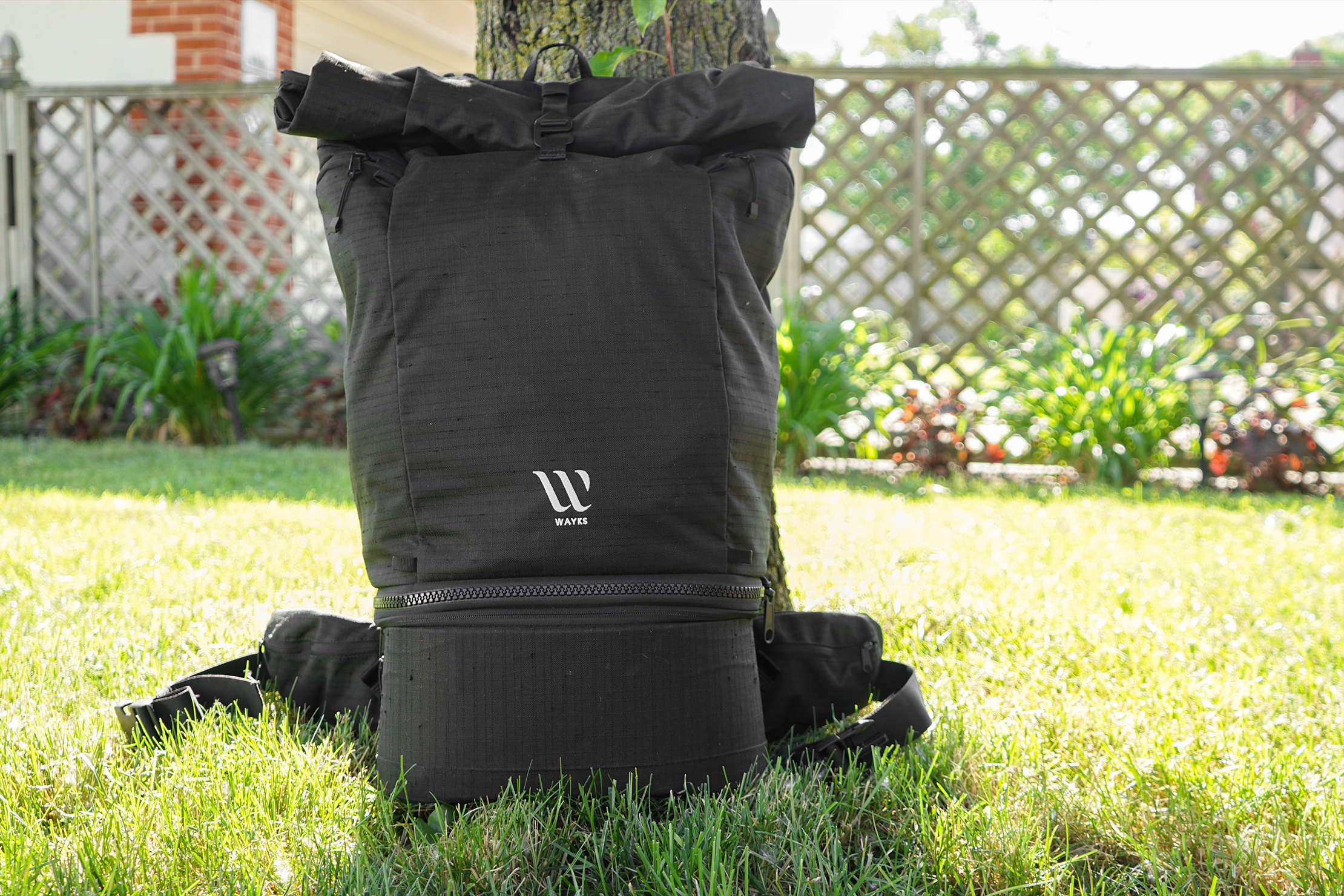
But, we’re happy to report that that’s not the case with the WAYKS ONE. We’ve been testing this thing for two weeks and counting—and it’s been performing really well.
As you may have surmised, there’s a lot going on with this backpack. So, grab a cup of coffee, tea, or your beverage of choice, and let’s dive straight into the full review.
Materials & Aesthetic
We’re digging the exterior fabric of the WAYKS ONE, which manages to be both thick and lightweight. It’s made of 600D polyester—91% (!) of which is recycled material. It has a Polyurethane (PU) weather-resistant coating that is PFC-free. The main lining is also polyester, while the lining on the detachable bottom of the pack (which we’ll discuss later) is nylon. The fabric has also been manufactured in a bluesign® approved factory recognized by the Fair Wear Foundation.
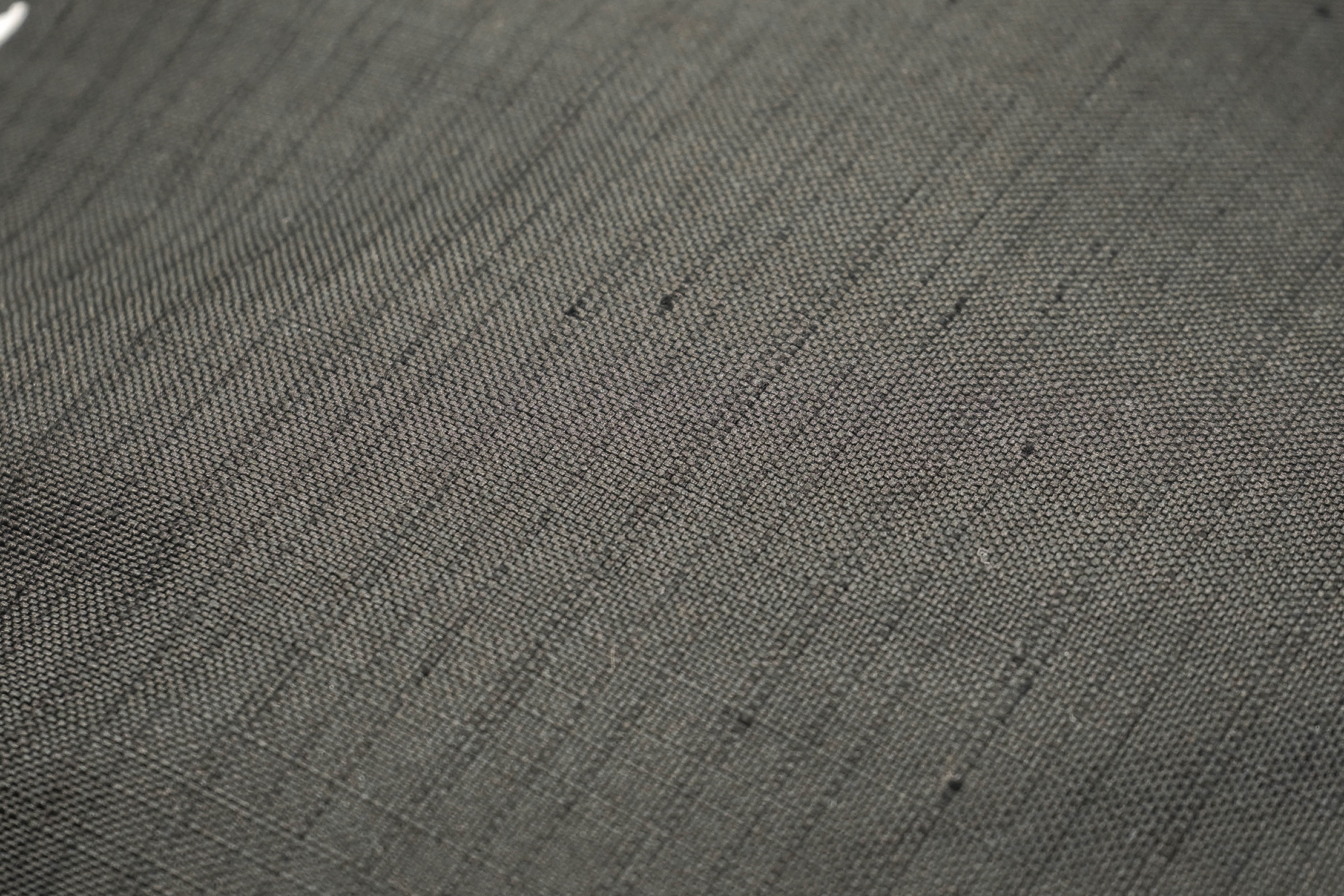
The zippers are from the reputable Japanese brand, YKK, which we’ve had tons of great experiences with. To be even more specific, the zippers on the exterior and interior of the main bag are YKK Natulon®, which are made using recycled content. (The zippers on the detachable bottom are YKK VISLON®.) On the quick-grab pockets, the zippers feature a weather-resistant PU coating to help protect your fragile items from, well, weather.
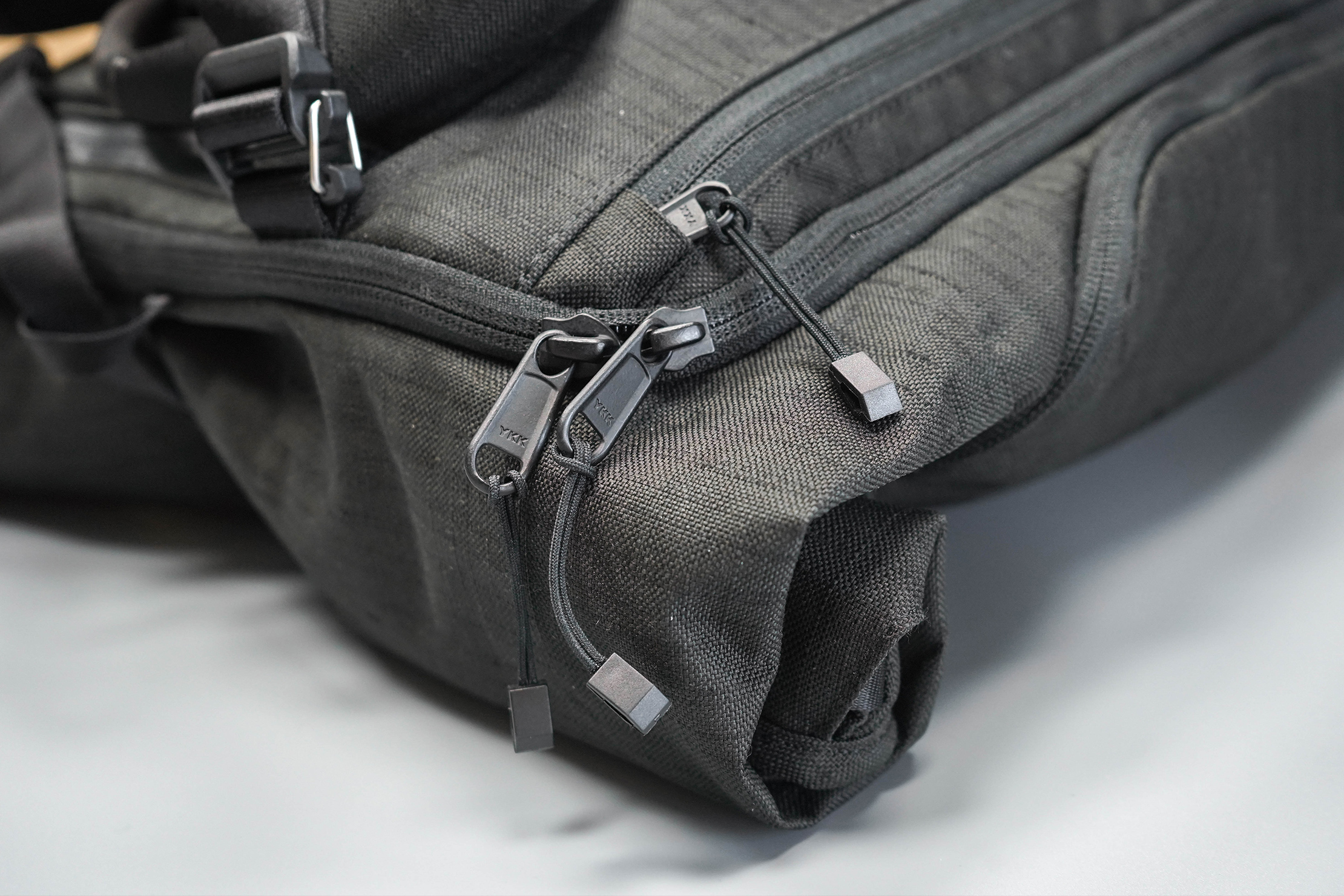
Finally, you’ll find Woojin hardware throughout the bag.
As for aesthetic, beauty is, of course, in the eye of the beholder. But we think it looks nice. Nothing to write home about, but nice. At the time of this review, it’s available in two colors—Black and Sand. We’ve been testing the black because, as you know if you’re familiar with us at Pack Hacker, we dig black gear (as our Digital Nomad Packing List proves). Additionally, the Sand colorway is very light…meaning it’s not going to hide stains and dirt too well. If you can handle a light-colored travel bag then all the more power to you. We’re going to stick with Black.
External Components
Okay—this is where things start to get a little complicated. WAYKS advertises that the ONE bag consists of 13 removable parts—several of which interact with one another. So, take another sip of your coffee, and let’s start with the harness system.
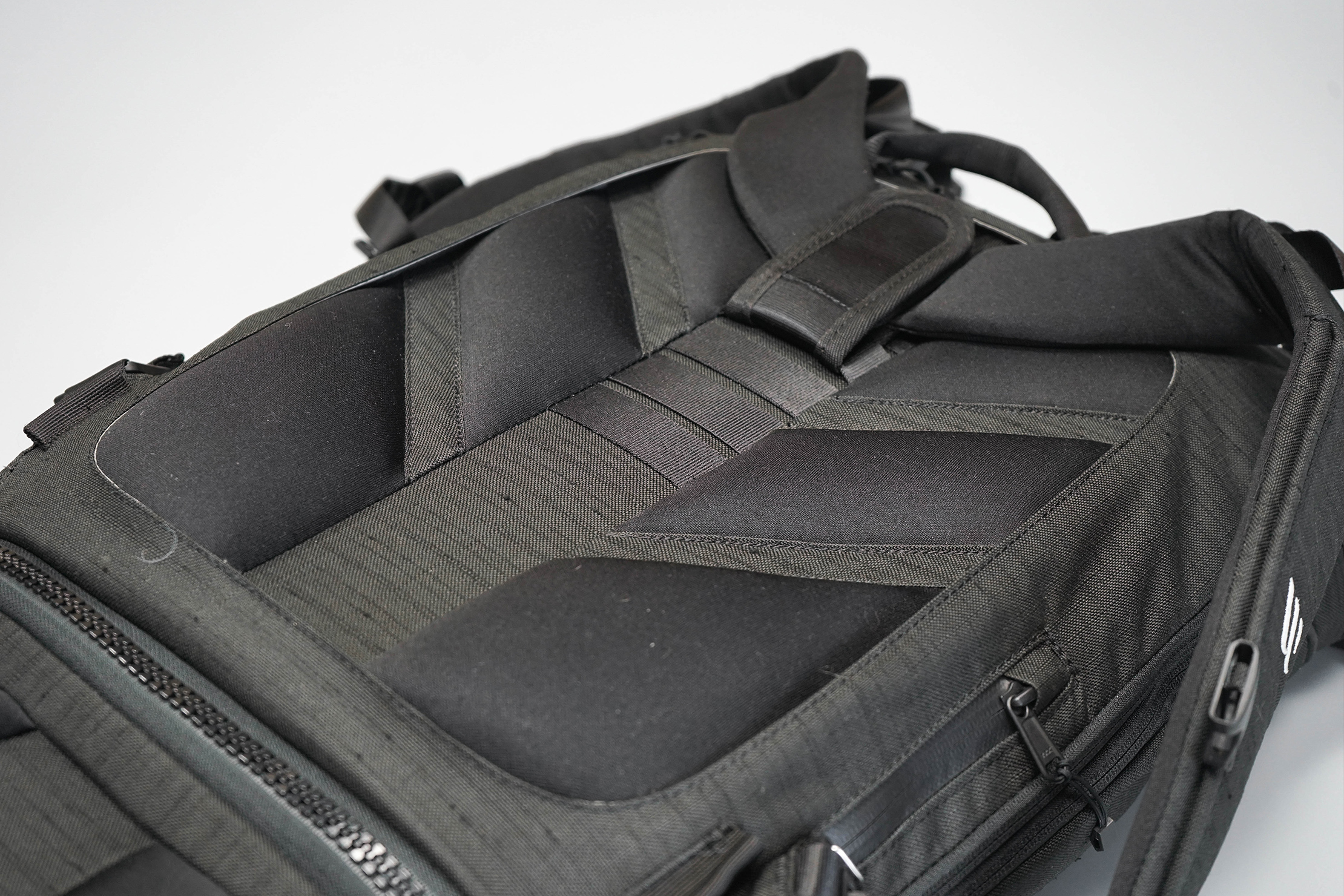
The back panel consists of super thick, dense padding. It’s thickest at the bottom where the bag presses against your lower back. And there are air channels for breathability (although, you’ll likely still encounter that dreaded Swamp Back). Overall, it’s nice and comfortable.

As are the shoulder straps, which feature that same thick padding. They’re also contoured to better fit the human body (sorry, robots). The shoulder straps themselves are adjustable, so you can customize their positioning to your height.
You adjust them by pulling a velcro latch through loops on the back panel. There are seven loops, and you have to use two of them to attach the shoulder strap. So that means there are four different height positions.
These loops are stiff—there’s no stretch to them. So, it takes some time to slide the velcro strap through the loops, especially if it’s not broken in (as in, you don’t use those loops frequently). While this can be a pain, we actually like that it’s so stiff as it will hold the shoulder straps securely in place.
The backpack straps hook into the bottom and top of the pack via gatekeepers (we’ll talk about why in a second). The problem with these buckles is that if you bump the gatekeeper, it can spring open without you noticing. And, therefore, the strap can become detached.
We haven’t experienced that phenomenon while testing this pack (yet), but we’ve experienced it while testing other packs with a similar style of attachment. It’s not a huge deal as it doesn’t happen frequently, but it’s worth pointing out.
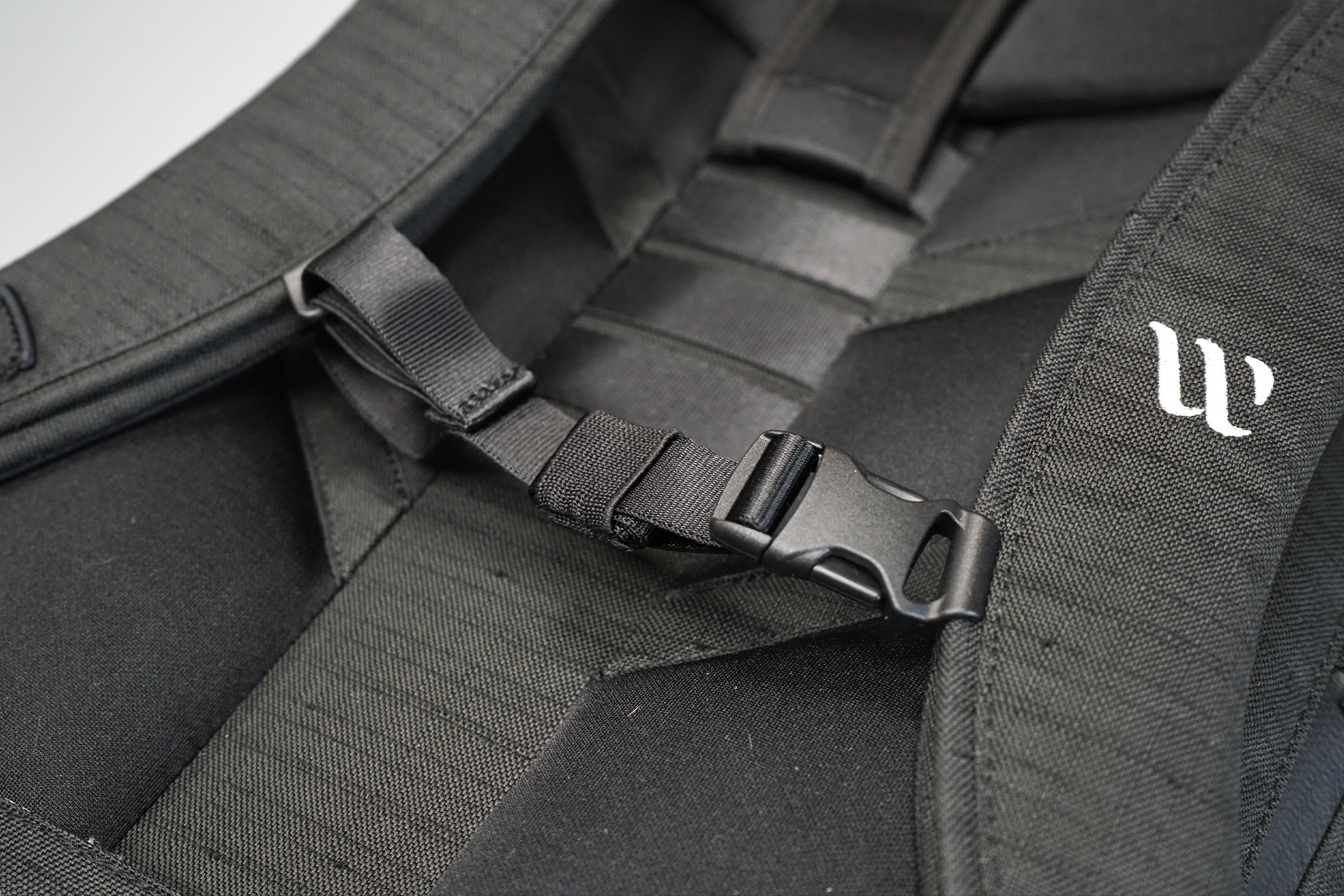
There’s also a sternum strap that you can adjust to your preferred height by sliding along a rail. We always like this style of sternum strap because 1) it’s highly customizable and 2) feels like it’s secure.
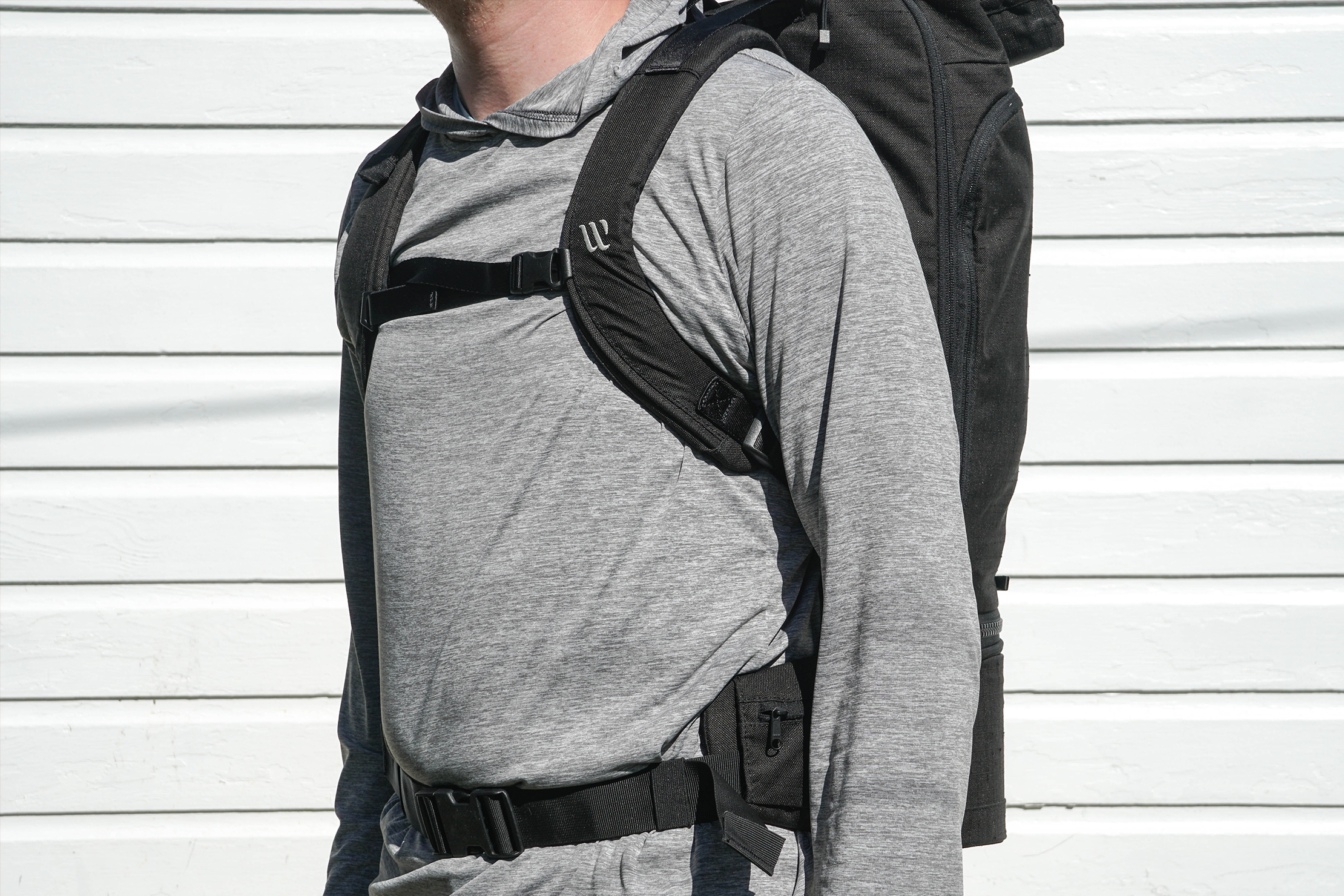
Additionally, there are load-lifters, which help you lift the load by pulling the bag closer to your back. Between the adjustable sternum strap, shoulder straps, and load-lifters (and hip belt that we’ll discuss in a minute), it may take you a hot second to get the backpack to fit your body correctly. But once you do, the carry becomes super comfortable.
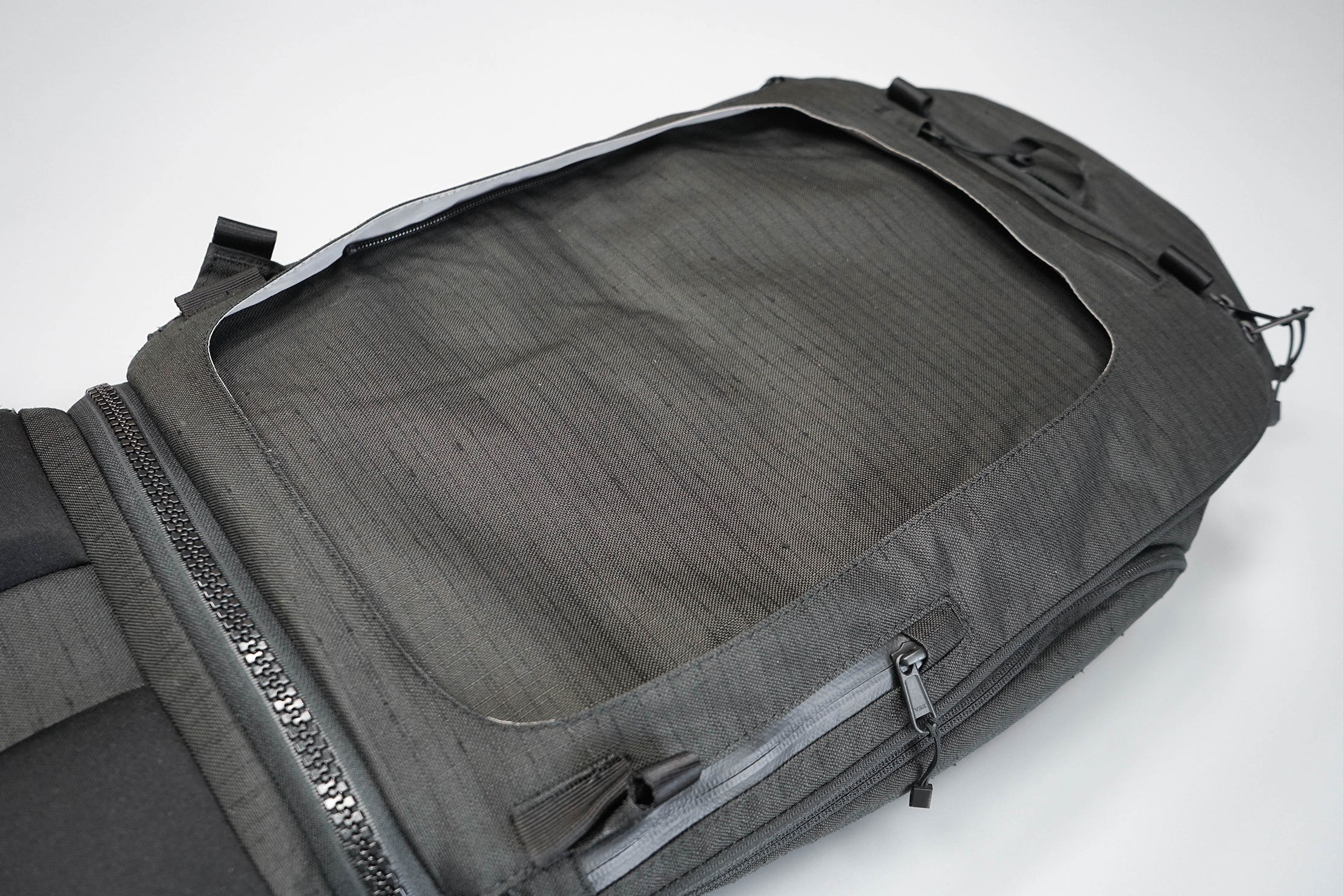
Before we talk about the final piece of the harness system—the hip belt—we want to point out that the entire aforementioned back panel—and the pieces of the harness system on it—are removable. Yes, you read that correctly. You can zip off the back panel, shoulder straps, load lifters, and sternum strap. This is why the shoulder straps attach via those aforementioned gatekeeper buckles. (Note that you can also remove the shoulder straps without having to remove the back panel.)

Once removed, you can replace the beefy harness system with simple nylon straps. Obviously, these straps are not the epitome of comfort. They’re thin and don’t have any padding or contouring. So, why would you switch out harness systems? In theory, it’s to shed some weight and make a more minimalistic bag whenever you’re carrying this thing as a day pack (without much stuff inside). However, we don’t think it’s worth the weight you save compared to the comfort you lose.
We’ve preferred to use the full harness system, even when not carrying much stuff. That said, you may appreciate the fact that you can go super lightweight for those day trips when you’re only bringing your phone and some sunscreen. Either way, it’s nice to have the option—you do you.
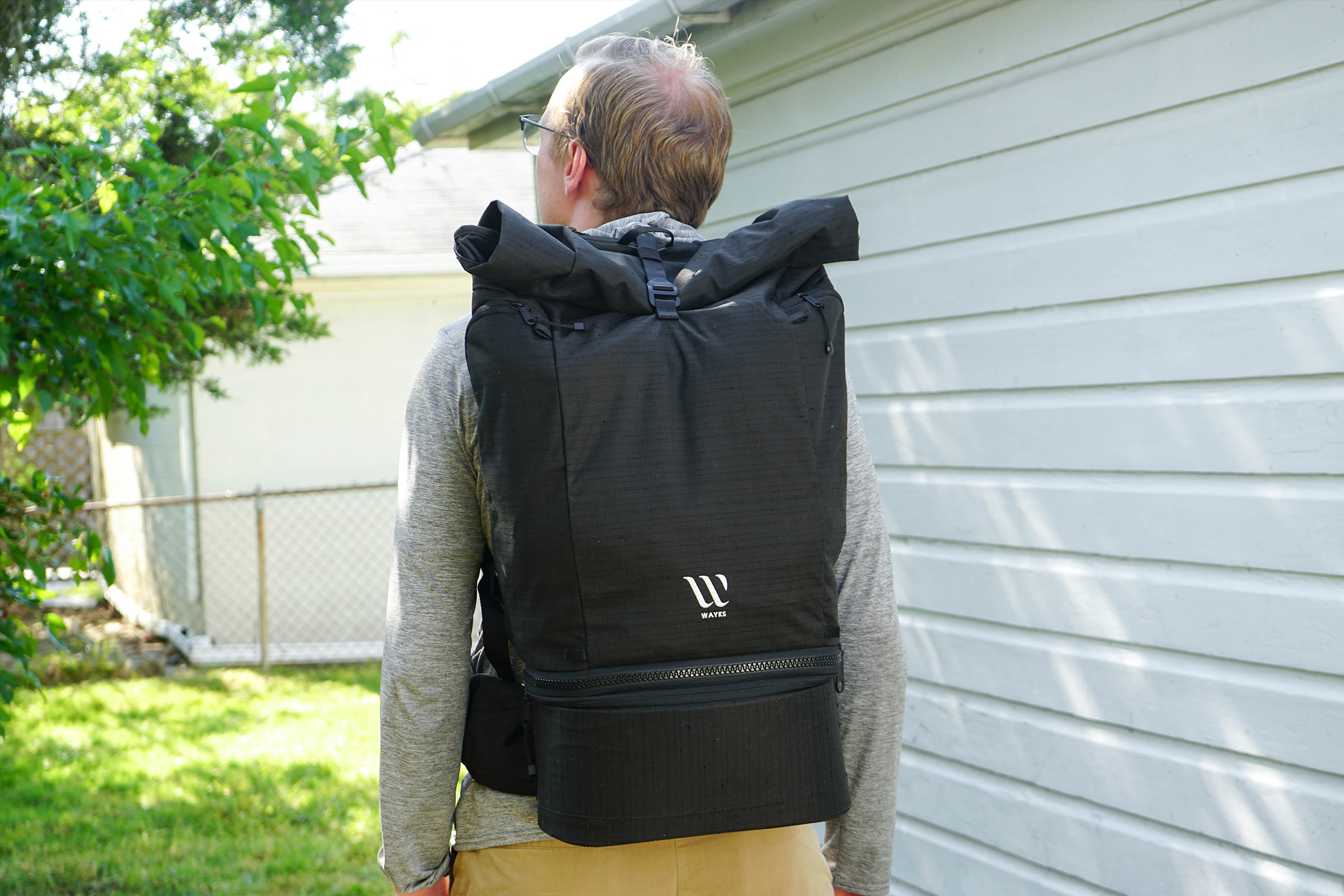
Okay—let’s talk about the hip belt, which is also detachable. As we’ve alluded to already and will discuss further in the next section, the bottom part of the backpack zips off, transforming this thing from a travel backpack into a daypack. The folks at WAYKS call this removable bottom part the “Cube,” which is how we’ll be referring to it from here on out. The hip belt attaches to the Cube, so it can only be used when you’re rocking this thing in its full travel bag glory. (Which is fine because you don’t need it in daypack mode.)
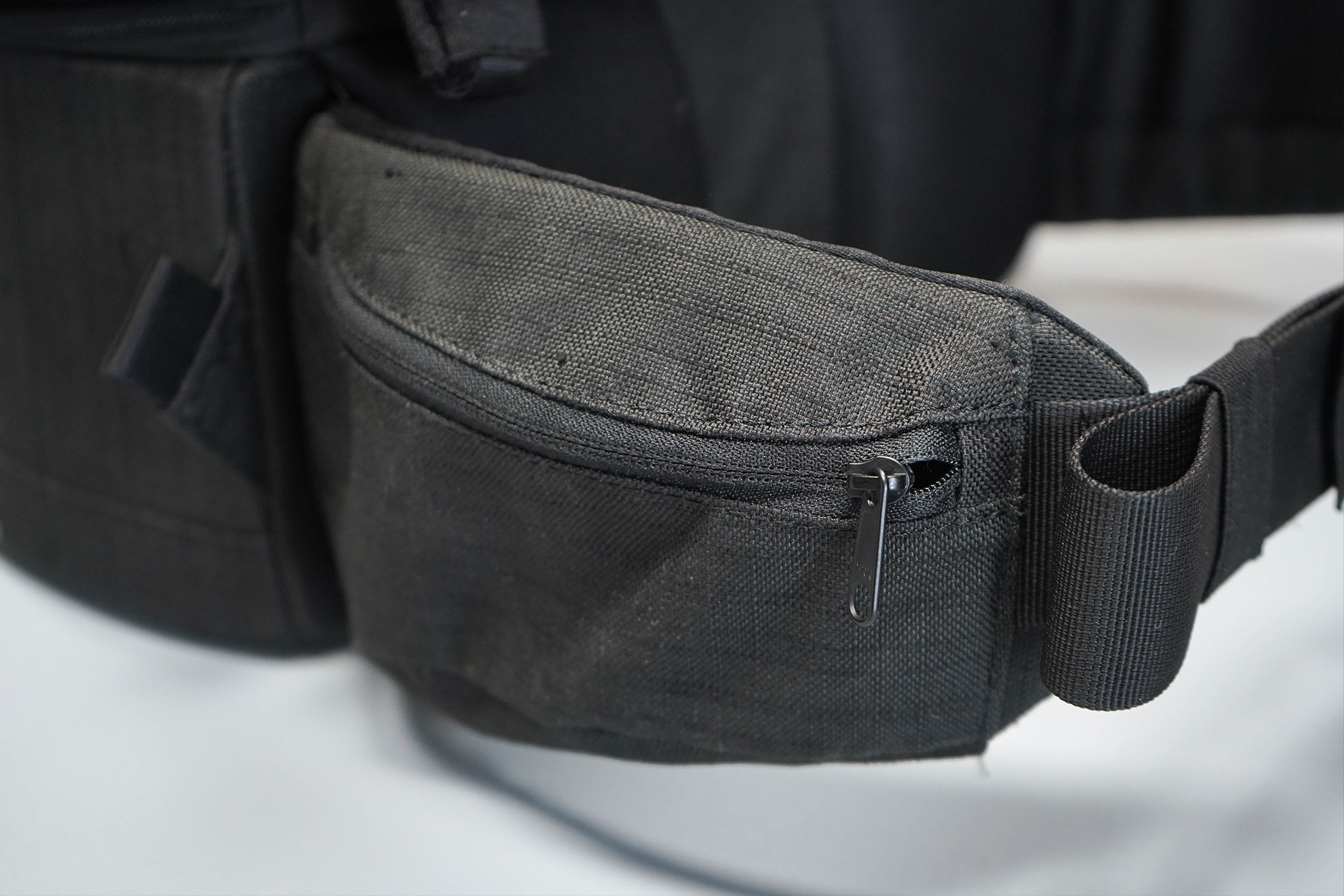
The hip belt features a ton of dense, thick padding, offering a great amount of support. We also like that the hip belt has two zippered pockets for quick-grab items (they’re not large enough to fit most smartphones, but are great for a snack, chapstick, wallet, etc).
To detach the hip belt (while still carrying this thing as a travel backpack), you simply slide it through its sheath.
If you detach the Cube, you can use the hip belt to carry it around as an intense fanny pack. We say intense because the Cube is large, structured, and bulky, so it looks ridiculous hanging off of your hips. But it’s an option.
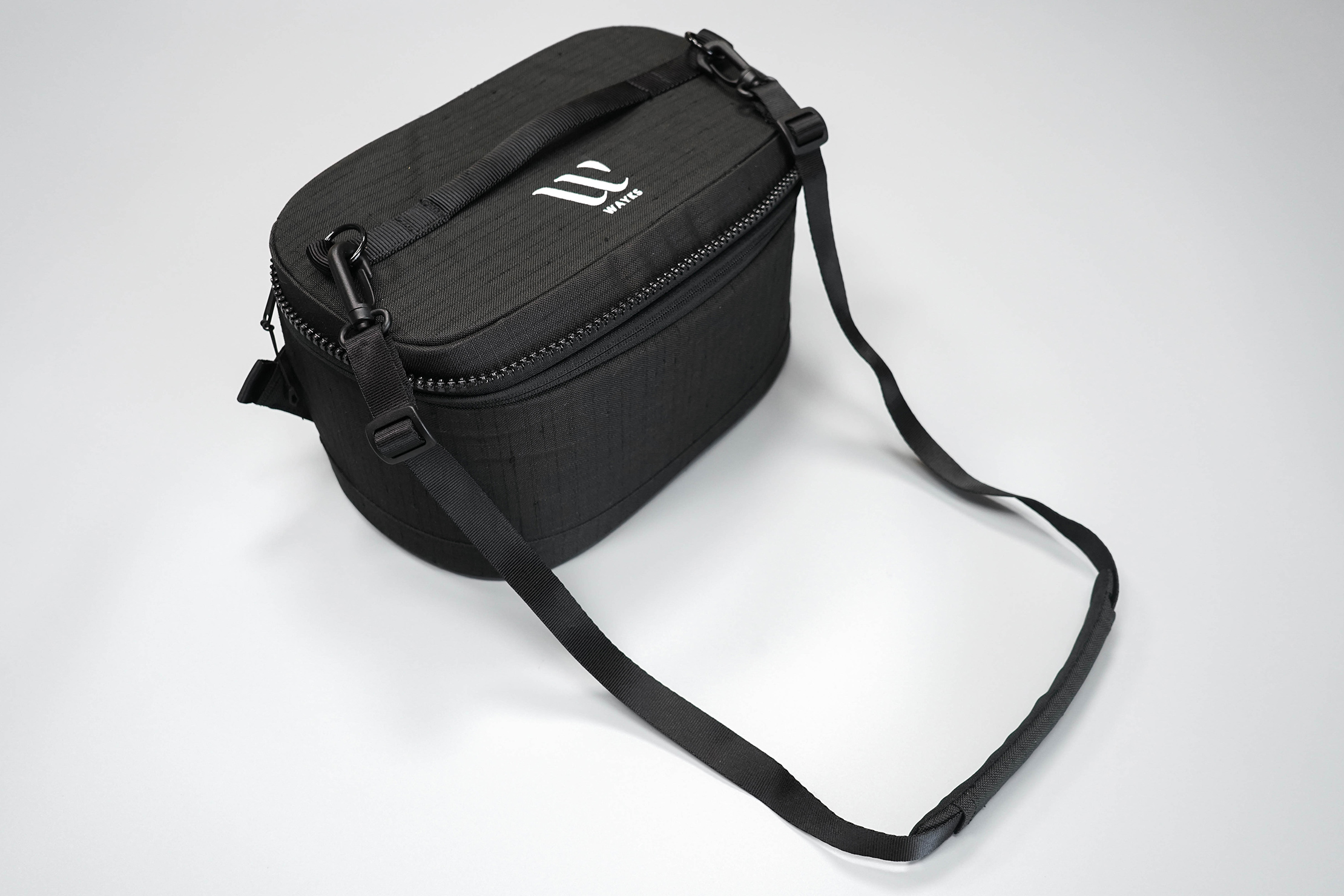
Luckily, you can remove the hip belt, and carry the Cube via its padded top handle or the shoulder strap that it comes with. The shoulder strap has some dense (albeit thin) padding, so it’s been comfortable to wear over one shoulder or crossbody.
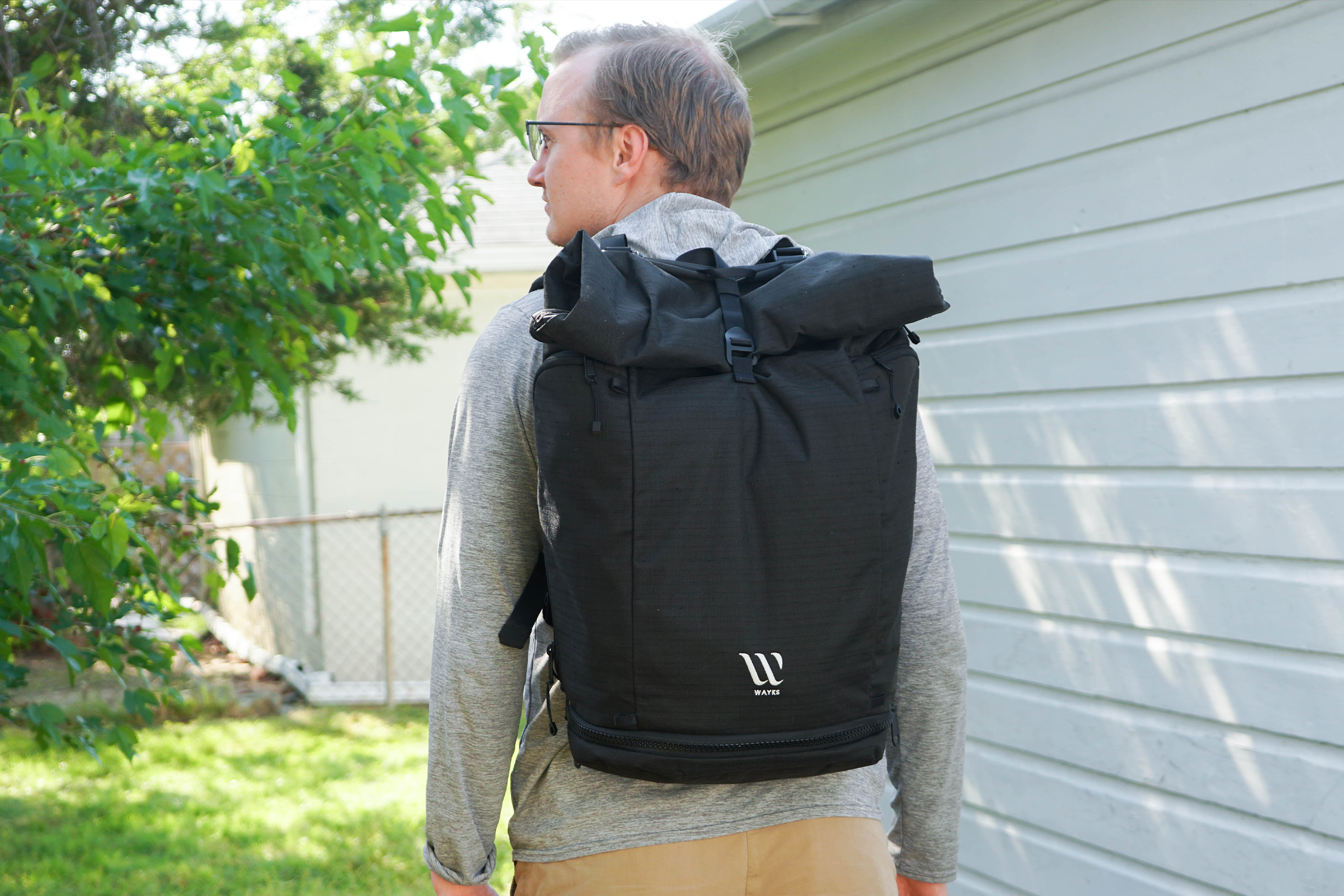
If you decide to detach the Cube, you’re left with the interior liner at the bottom of the bag. The liner ensures your stuff won’t fall out, but it’s not great for durability or looks. But don’t worry, there’s a separate piece made with the same material as the rest of the pack that zips in place to give this thing a real bottom (functionally and aesthetically) when in daypack mode.
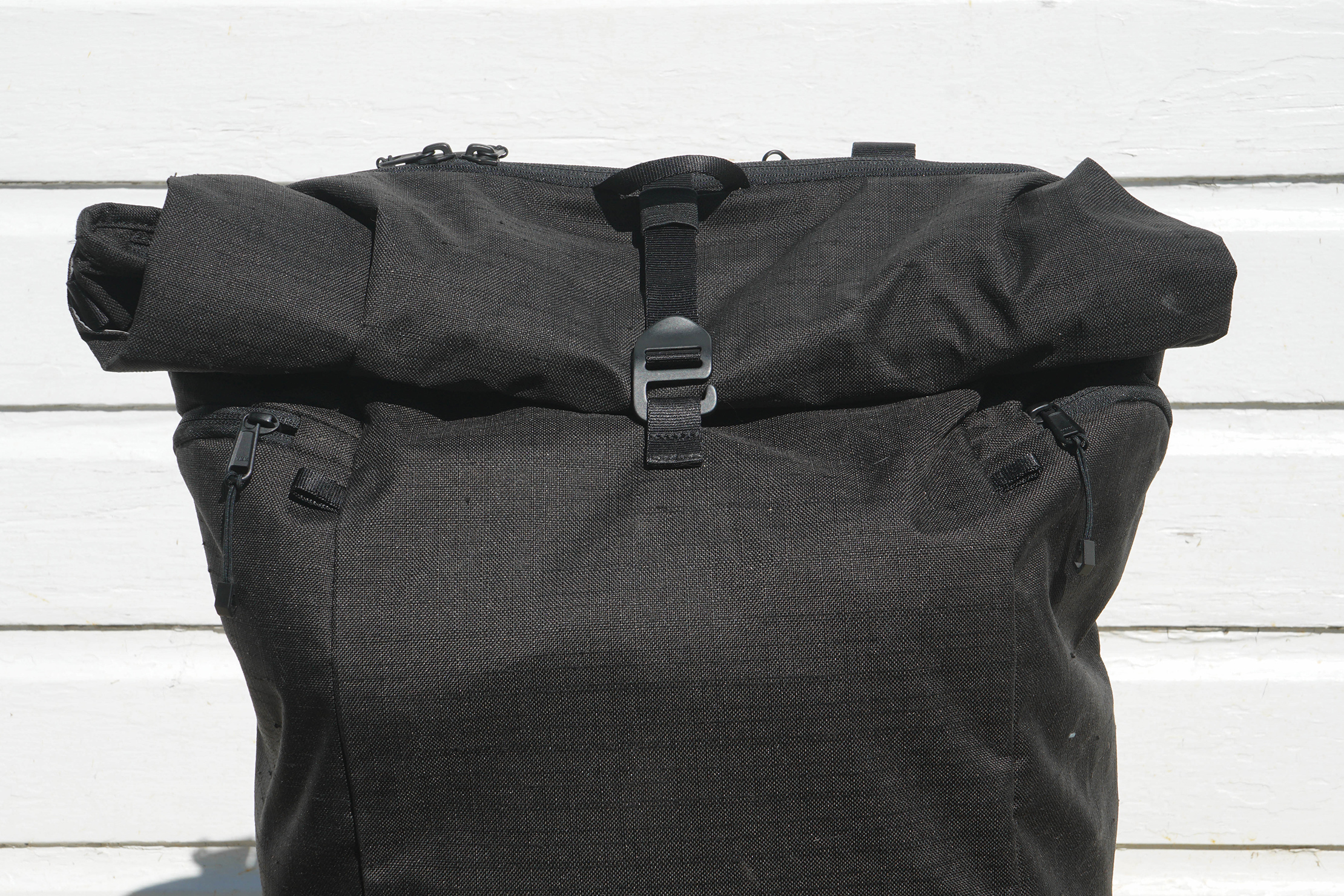
The main pack has a roll-top style of opening, which can be closed in one of two ways. You can roll the fabric over and hook it in place with an aluminum G-hook. Or you can half-roll it and clip it together via a plastic buckle.
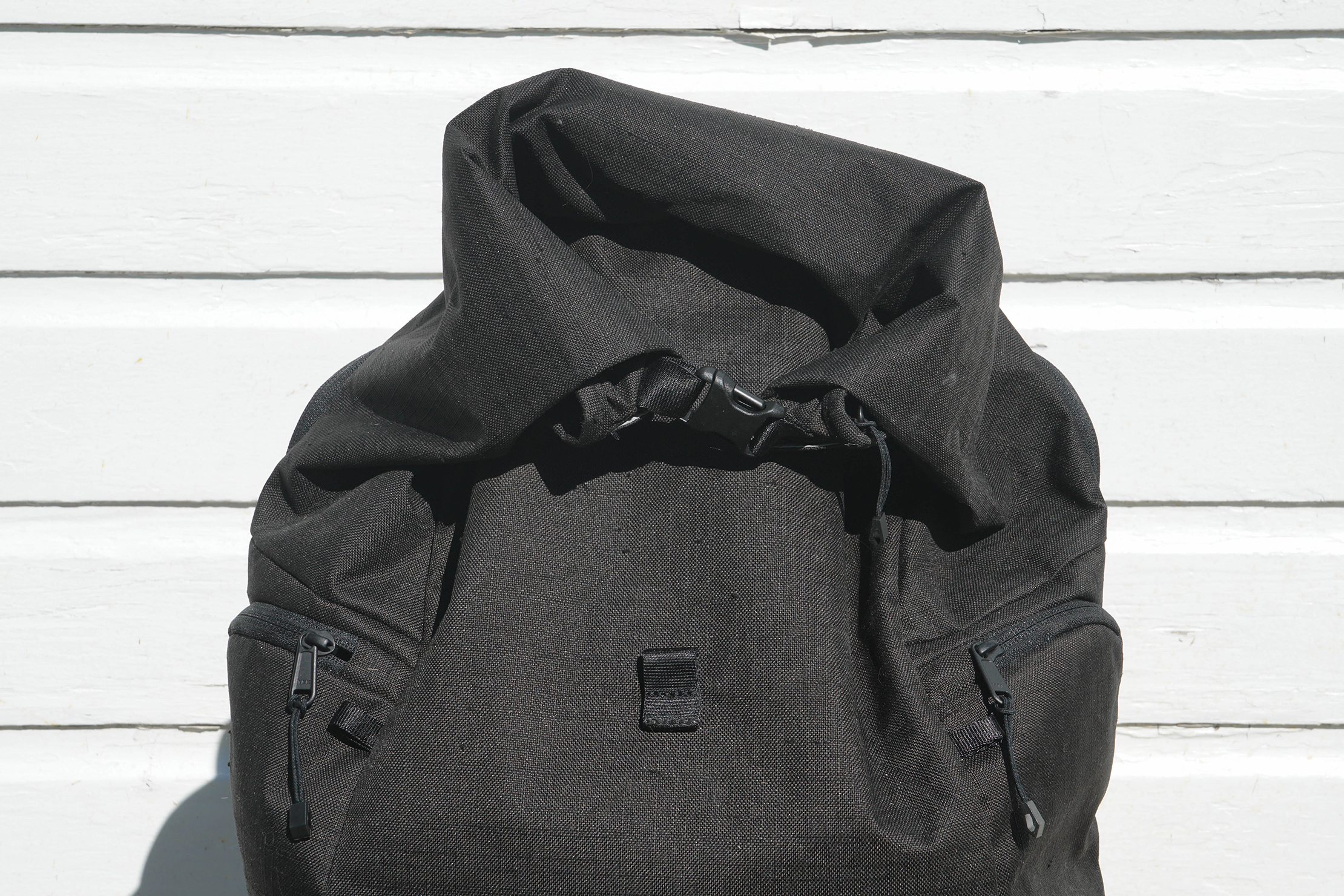
Both options work great—it simply comes down to personal preference. We like that the G-hook and plastic buckles tuck away whenever you’re not using them. So, if you’re a G-hook person, you can stow the plastic buckles and never have to look at them again (and vice versa). It helps give the pack a clean look and gives us that precious #DangleFreeExperience.
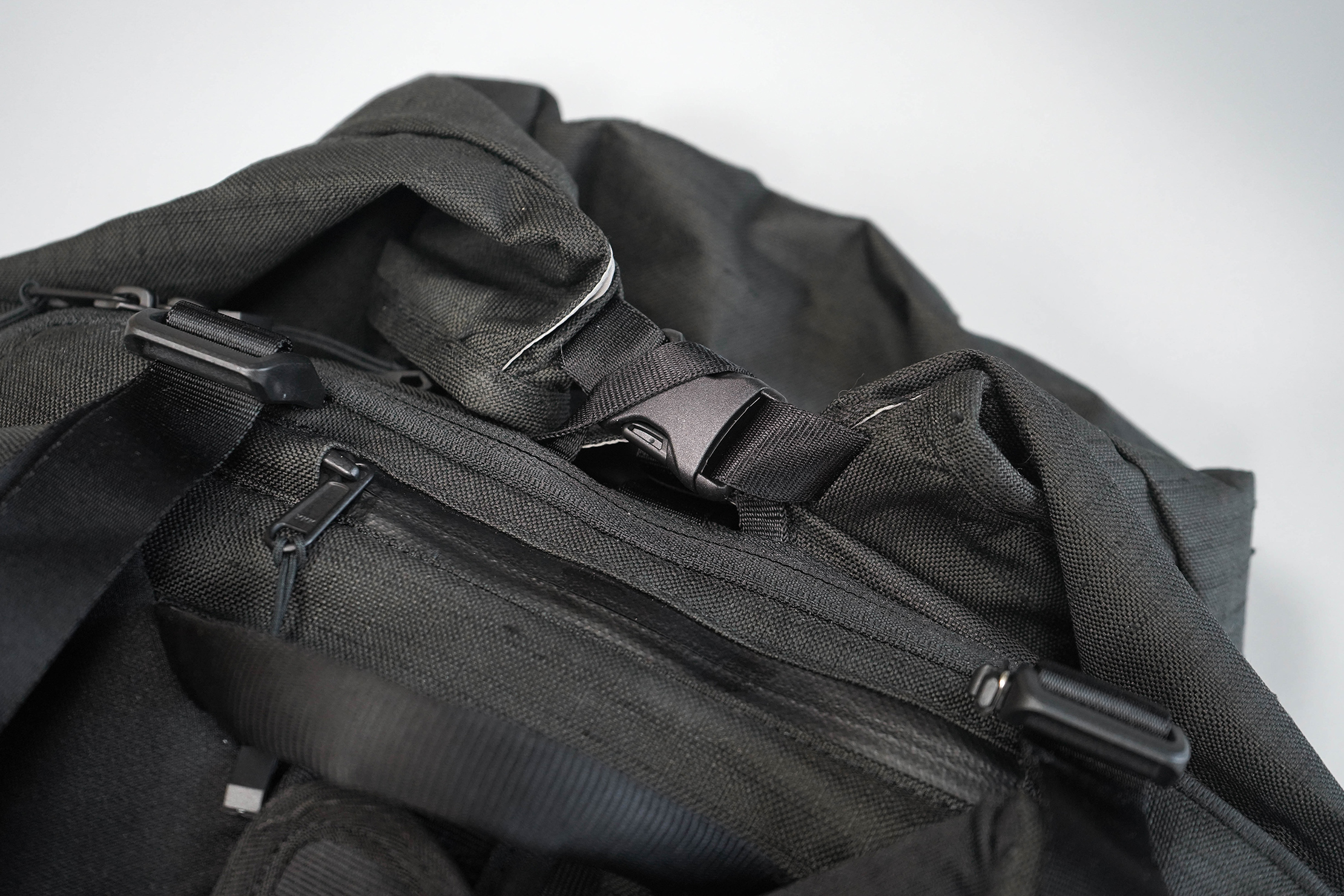
There are two handles on the pack. One is a small, simple nylon loop that can’t hold a lot of weight. You should only use it when you have removed the back panel. The folks at WAYKS say that should you choose to close the roll-top via the plastic buckle, you should clip it through the handle to keep it securely in place.
The other handle is padded and can bare weight, so you can use it when this thing is fully packed out for all your grab handle needs.
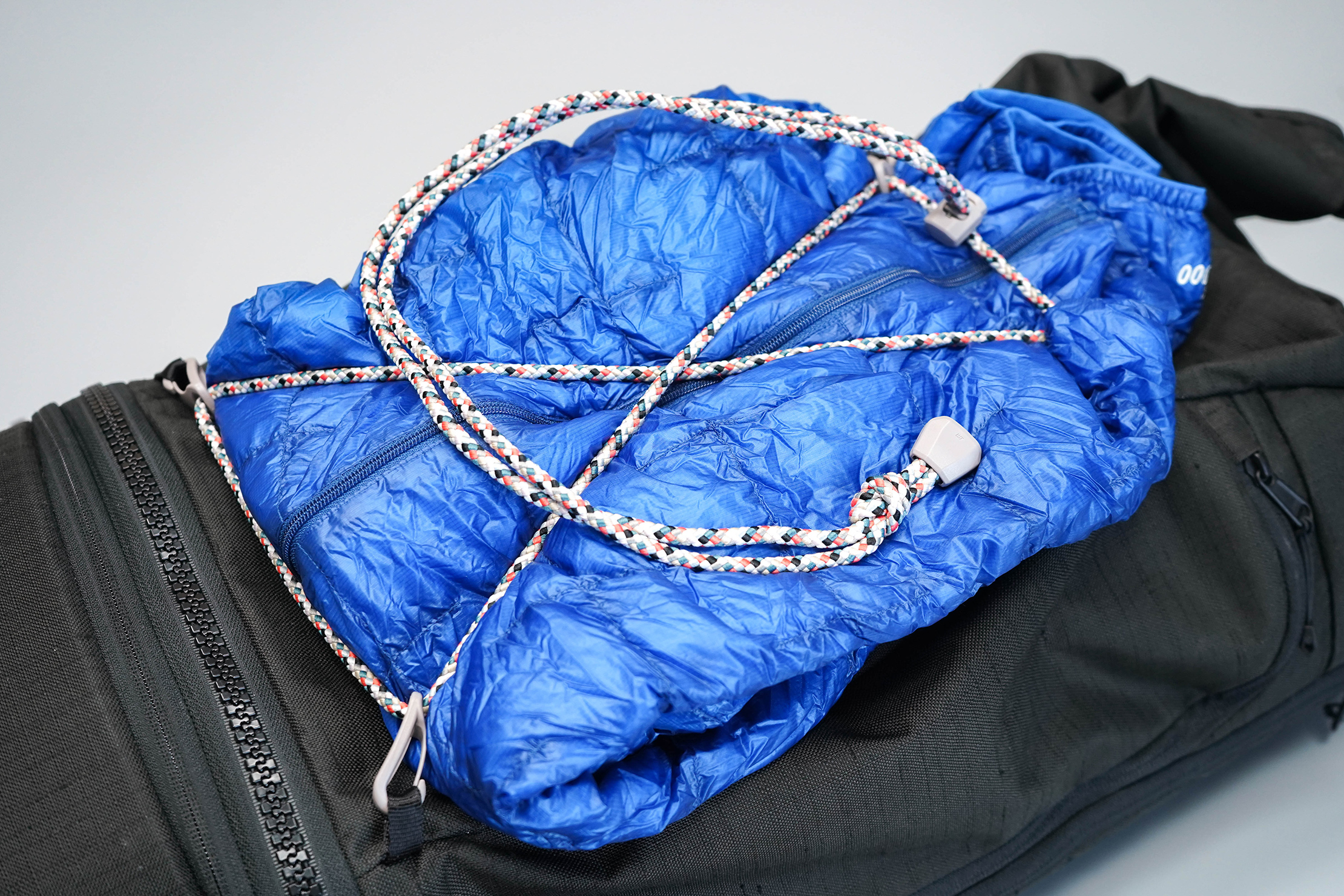
You can buy a “mat strap” accessory that you can string across the front of the pack to hold a variety of gear externally—think yoga mat, jacket, or tripod. The strap isn’t stretchy at all, so anything you tuck into it needs to be a tight fit. Otherwise, it can slip out of the sides. So, we would’ve liked the strap to be elasticated.
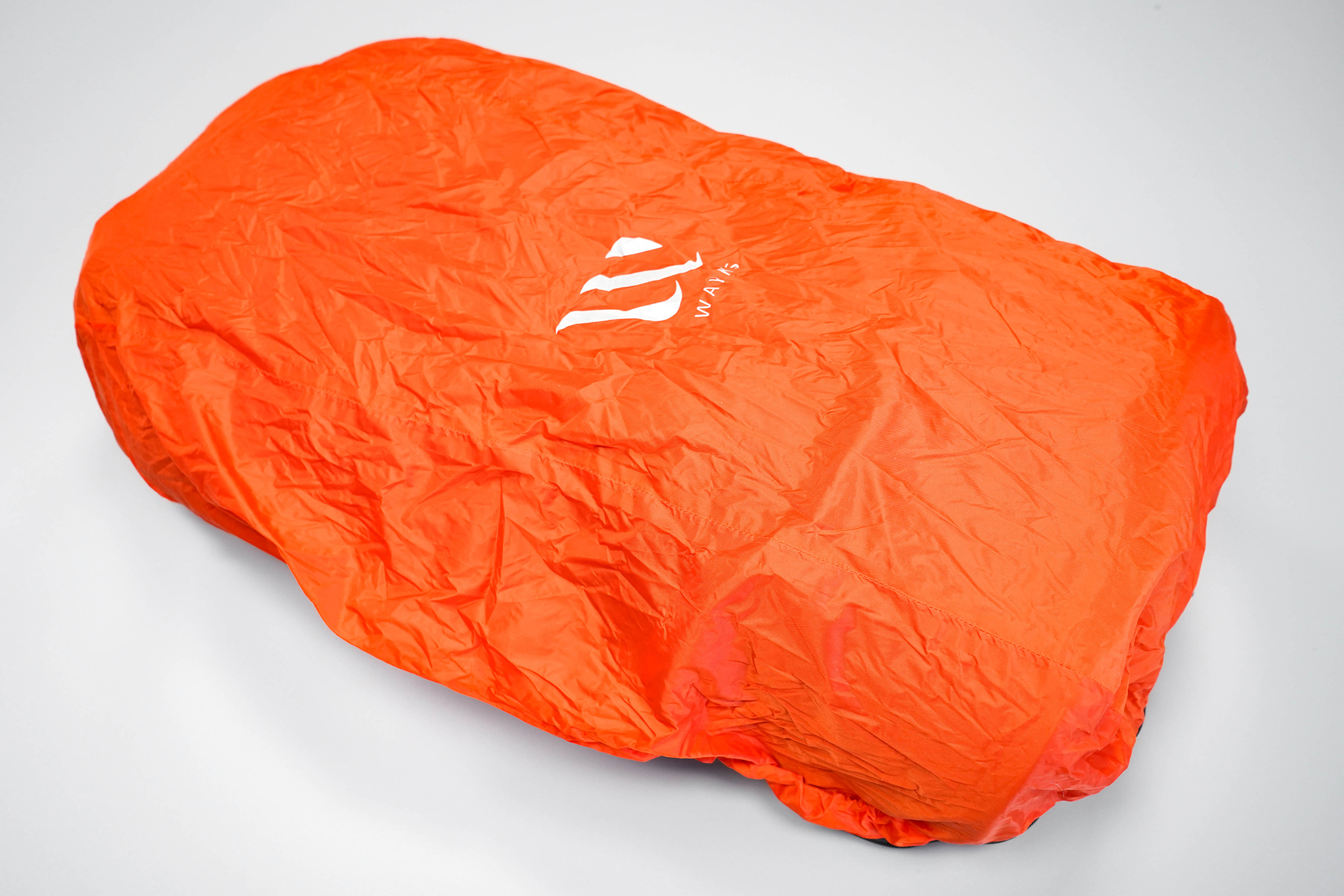
You can also buy a rain fly for extra weather protection. It has been designed to fit the length of the pack when it’s in travel bag mode, but it’ll fit when it’s been transformed into a day pack too. Only with a little extra fabric bunched up. It’s also bright orange, which is both fun and helps with visibility. Win, win (if you’re into bright colors, of course).
Phew—complicated, right? But, despite everything that’s going on, we have to say that the pack feels cohesive. All the removable parts make it quite versatile too, something that we appreciate.
That said, we haven’t reached the end just yet. We have the entire interior of the pack to look at. So, do a couple of jumping jacks, refill of your beverage-of-choice, and let’s zip this sucker open.
Inside the Pack
Let’s start with the aforementioned Cube. As we’ve already said, the Cube can be a compartment on the bottom of the pack, or you can zip it off and carry it separately. It’s essentially a structured box of open space to put things like shoes or other chunky gear. We like that the Cube has a ton of structure to it, so you don’t have to worry about your fragile stuff getting squished or damaged. The folks at WAYKS also say that the insulated lining also means the Cube works as a small cooler.
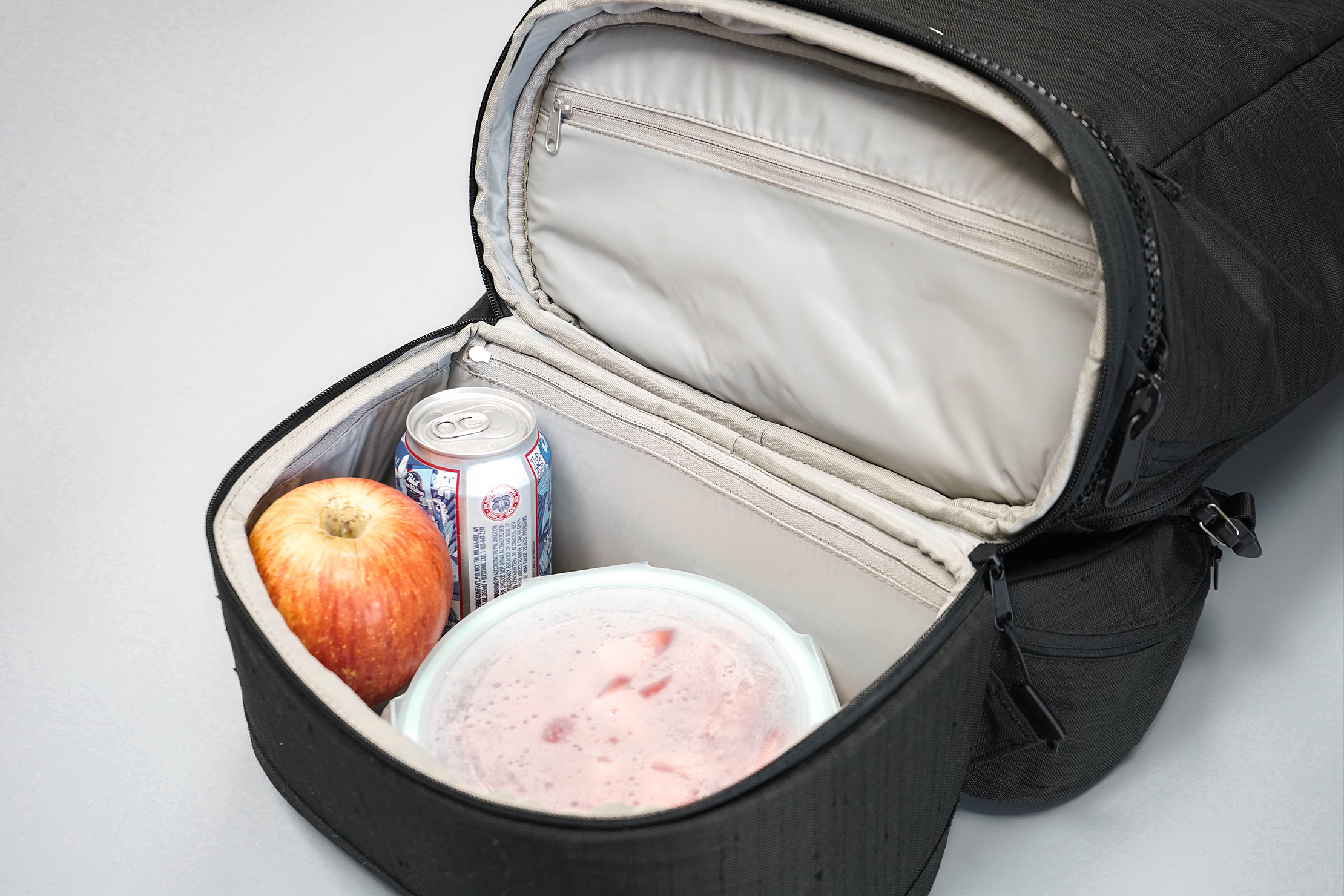
Now, you can buy the WAYKS Cube Inlay to put inside of the Cube. The inlay is an organizer that has several soft, padded dividers, designed specifically to hold your camera and camera equipment. So, the Inlay turns the Cube into a Camera Cube. Which is how we’ve tested it. But the Inlay could also work to compartmentalize makeup, toiletries, your baseball card collection, whatever.
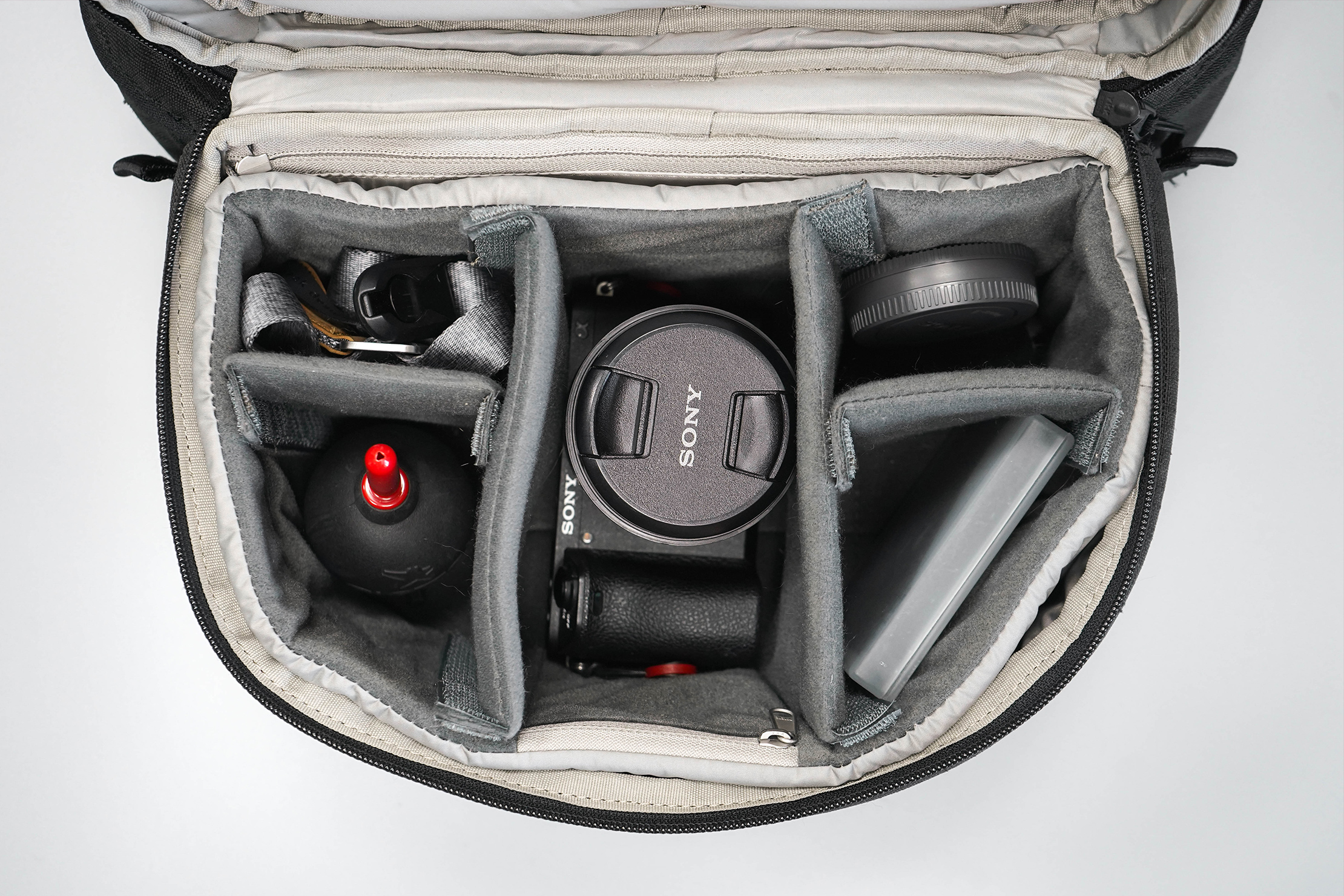
On the top interior of the Cube, there’s a zippered pocket for a little bit of extra organization.
Alright, moving on to the main part of the bag.
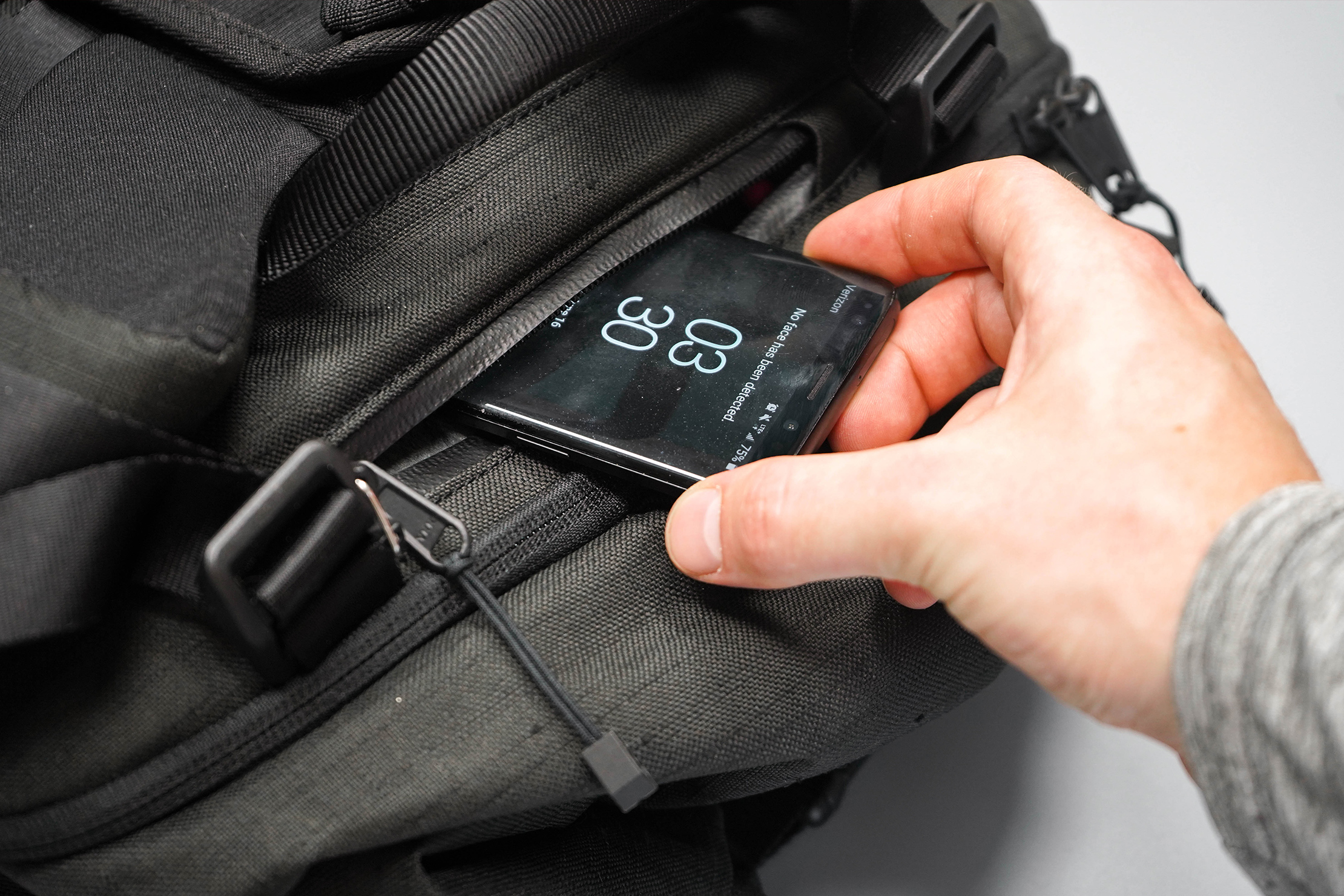
There are two quick-grab pockets, both of which sit on the backside of the WAYKS ONE. They both have a faux-fur liner to help protect your fragile gear—phone, sunglasses, glass figurine collection, etc. The “fur” is also fun to pet, especially if you don’t have a real pet in your life (…just us?).
The first one sits at the top of the pack. Inside, there’s a pen holder. Which, to be frank, seems like an odd spot for a pen holder. It sits past the zipper, making it difficult to access. But if you carry around a really fancy pen then maybe you’ll appreciate it. The second quick-grab pocket sits on the side of the pack and is nearly identical—minus the pen holder.
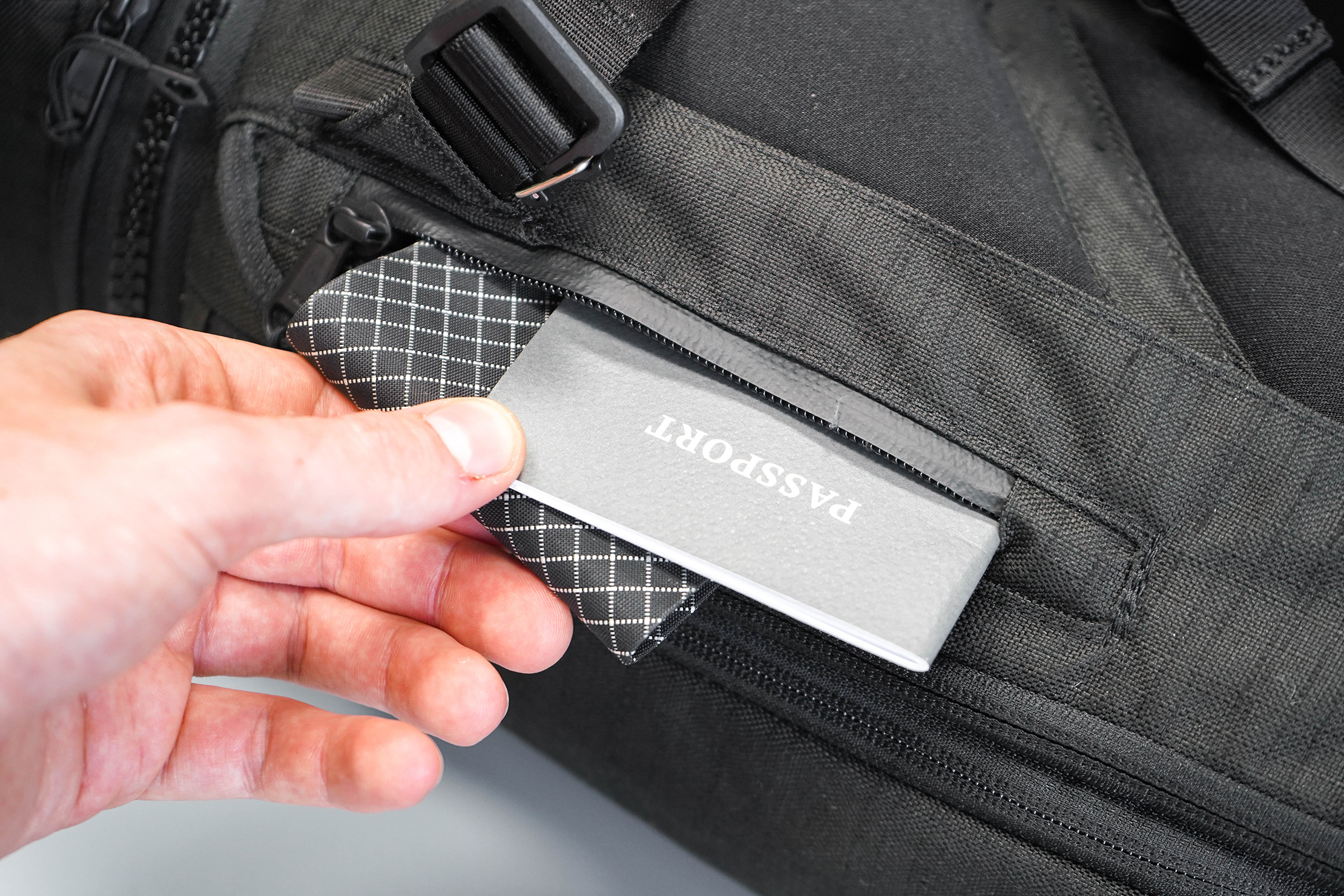
If you’ve zipped off the back panel, you can feel whatever items you put into these pockets against your back quite well. So, keep that in mind. For example, you won’t be having a good time if you’ve decided to keep your favorite pointy sticks in the top pocket and your favorite bulky rocks in the side one.
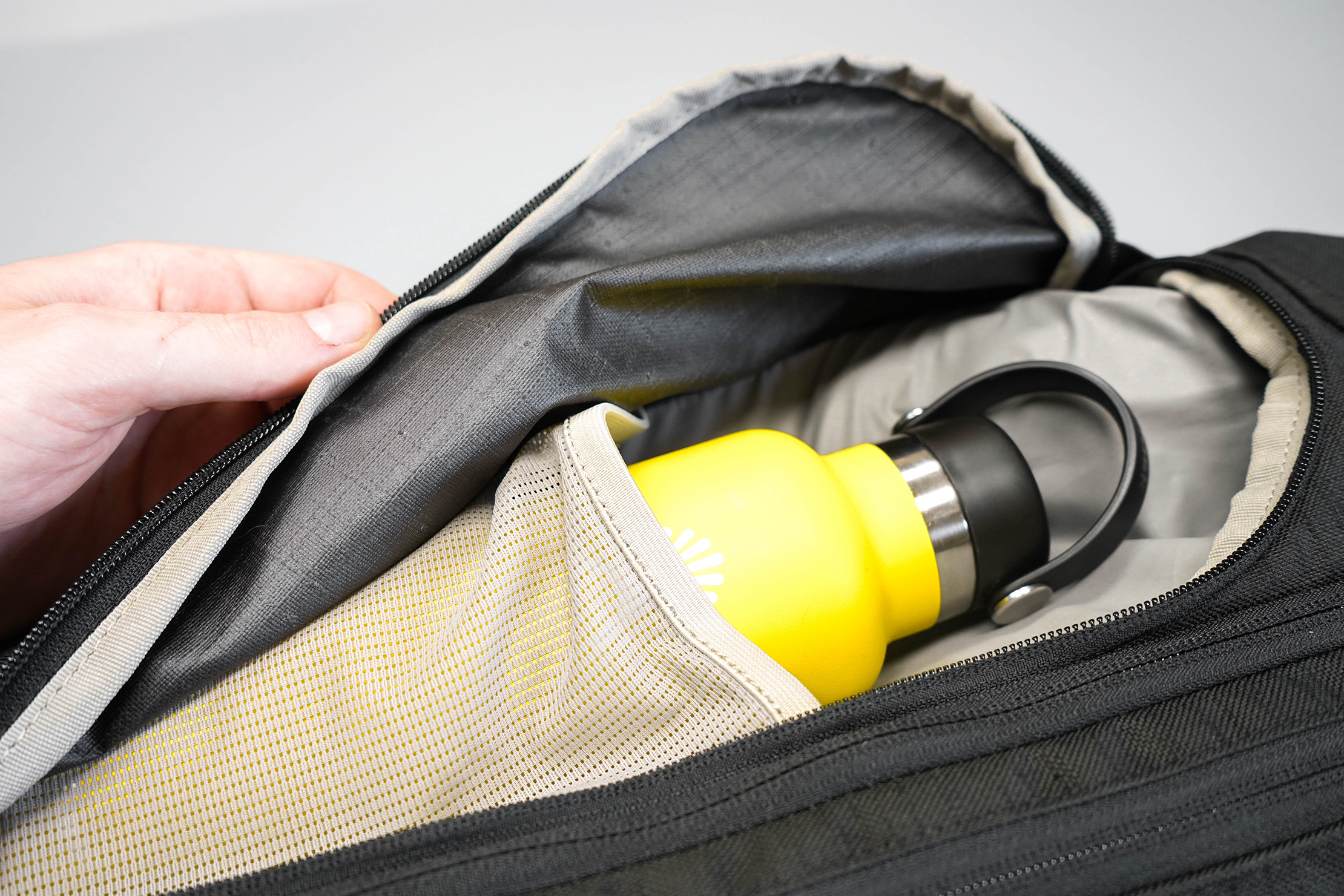
There are two zippered pockets—one on each side of the bag. Inside of both pockets, there’s a long, elasticated mesh pocket. These work particularly well for water bottles—including large ones like the 21oz Hydro Flask—but you can use them for other stuff too. Just note that they cut into the capacity of the main compartment.
And that brings us to the main event. Let’s take a look at the main compartment. As we mentioned earlier, the main compartment has a roll-top opening, which is where the expandability comes in. In travel pack mode, the capacity is 30L when you have the top rolled all the way down and 45L when it’s filled. In day pack mode, the capacity is 25L rolled, and 40L expanded.
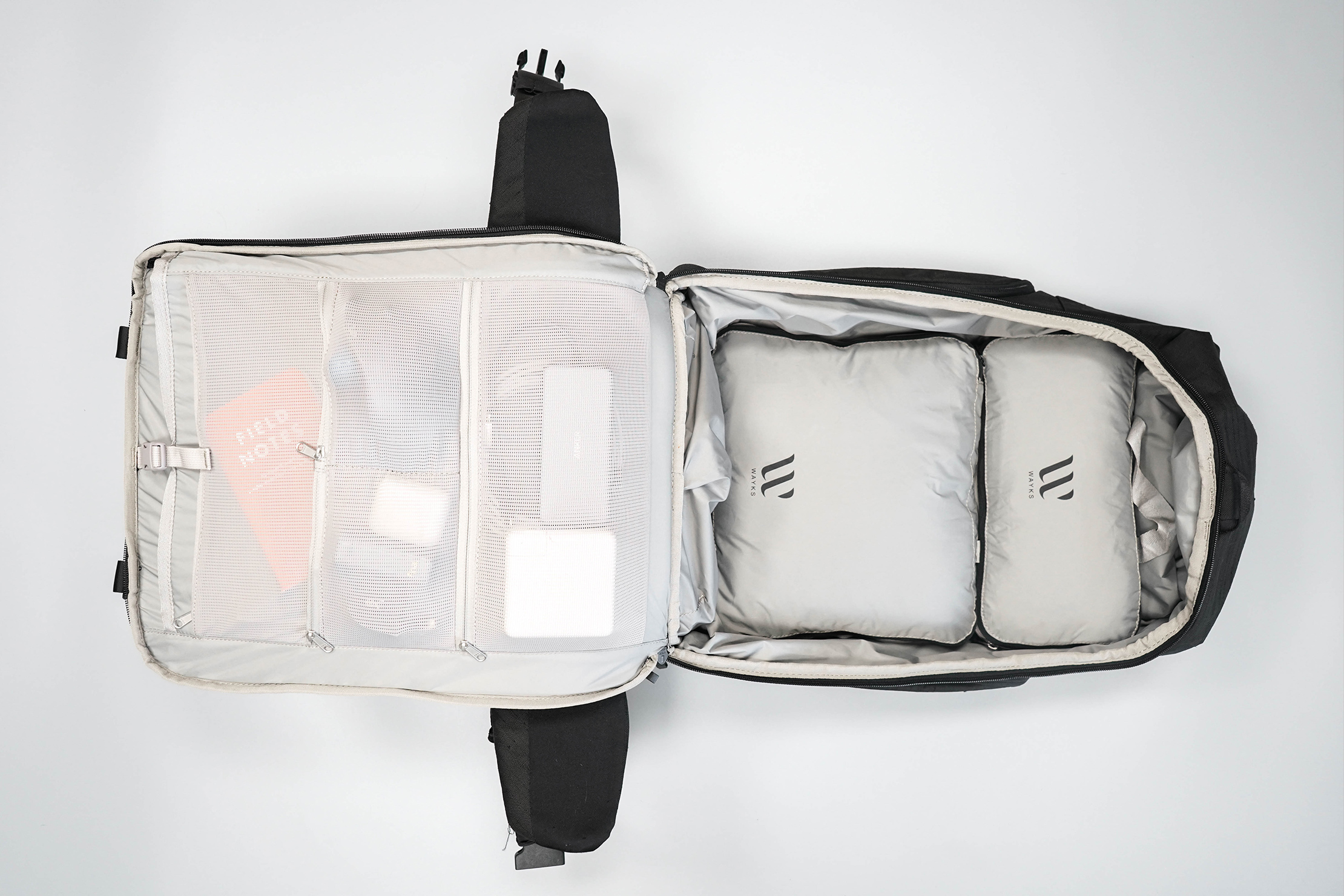
Roll-tops can be difficult to see into and access, which is why the WAYKS ONE has a second, clamshell-style of opening. We love this dual-access feature. And we don’t use the word “love” lightly. It’s super convenient not only for access and visibility but for packing this thing up. And, if you don’t have a need for a full clamshell opening, you can get into it via the roll-top.
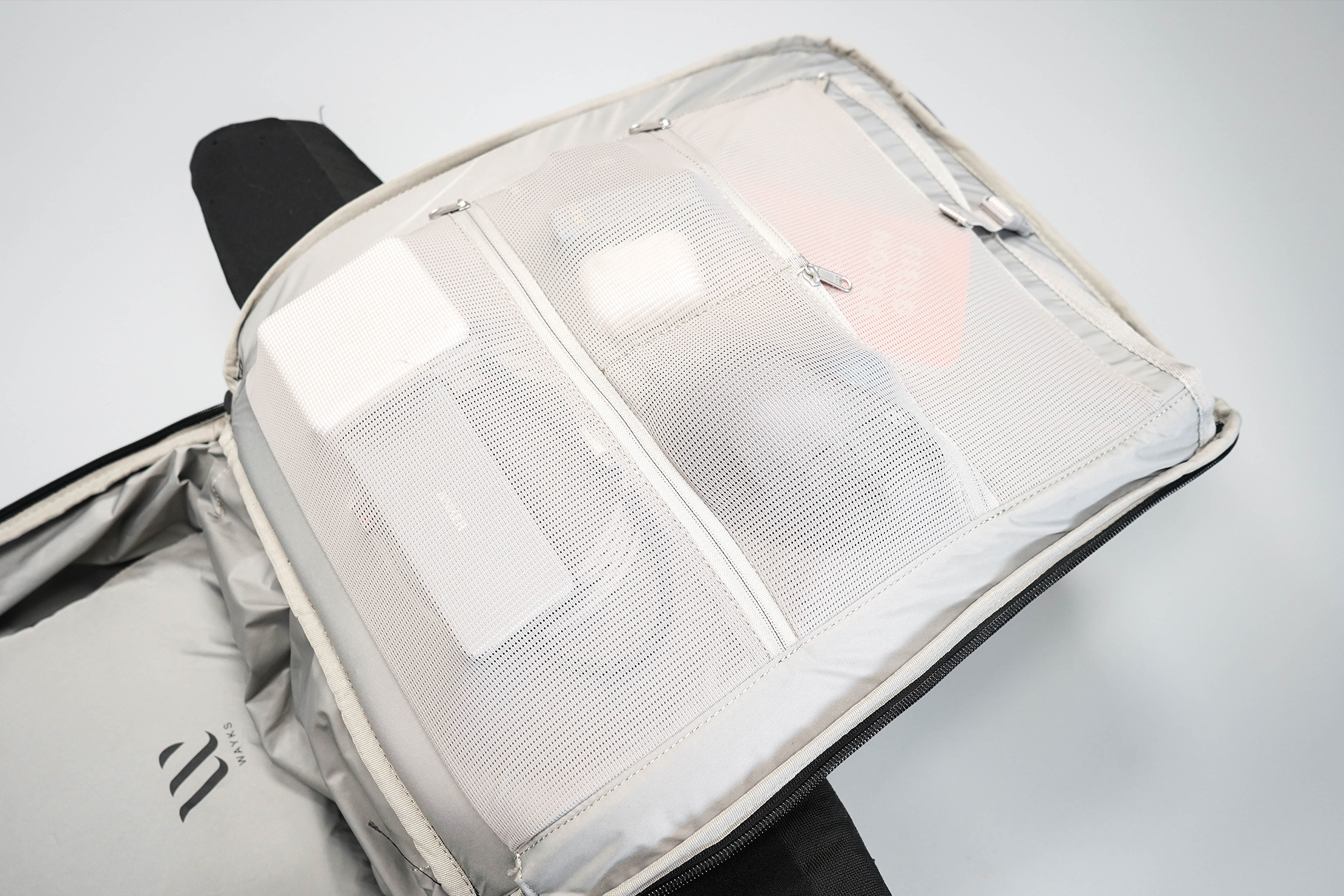
Against the back of the compartment—on the interior of the back panel—there is a bit of organization going on. There are four mesh pockets, which is a good amount of organization for tech gear.
The top pocket goes ⅔ of the way down the length of the compartment, sharing the same space as the other pockets. So, if you put smaller stuff into this pocket, it will fall to the bottom, and cut into the usable space of the other pockets. Because of this, it works best with thin, flat items. We don’t have lots of thin, flat items in our setup, so we would’ve preferred if this pocket was shorter and ended where the next row of pockets began. Of course, depending on your kit, this may work better for you.
The next two mesh pockets are in the middle row. They divide the width of the space in half, so they’re great for organizing your smaller items. Say AirPods, adapters, or the other random bits and bobs of your setup.
The final mesh pocket is at the bottom of this space. It’s great for thicker items—say a computer charger. We like that these mesh pockets are general enough that they’ll work for a variety of gear. You can really use them however you need to.
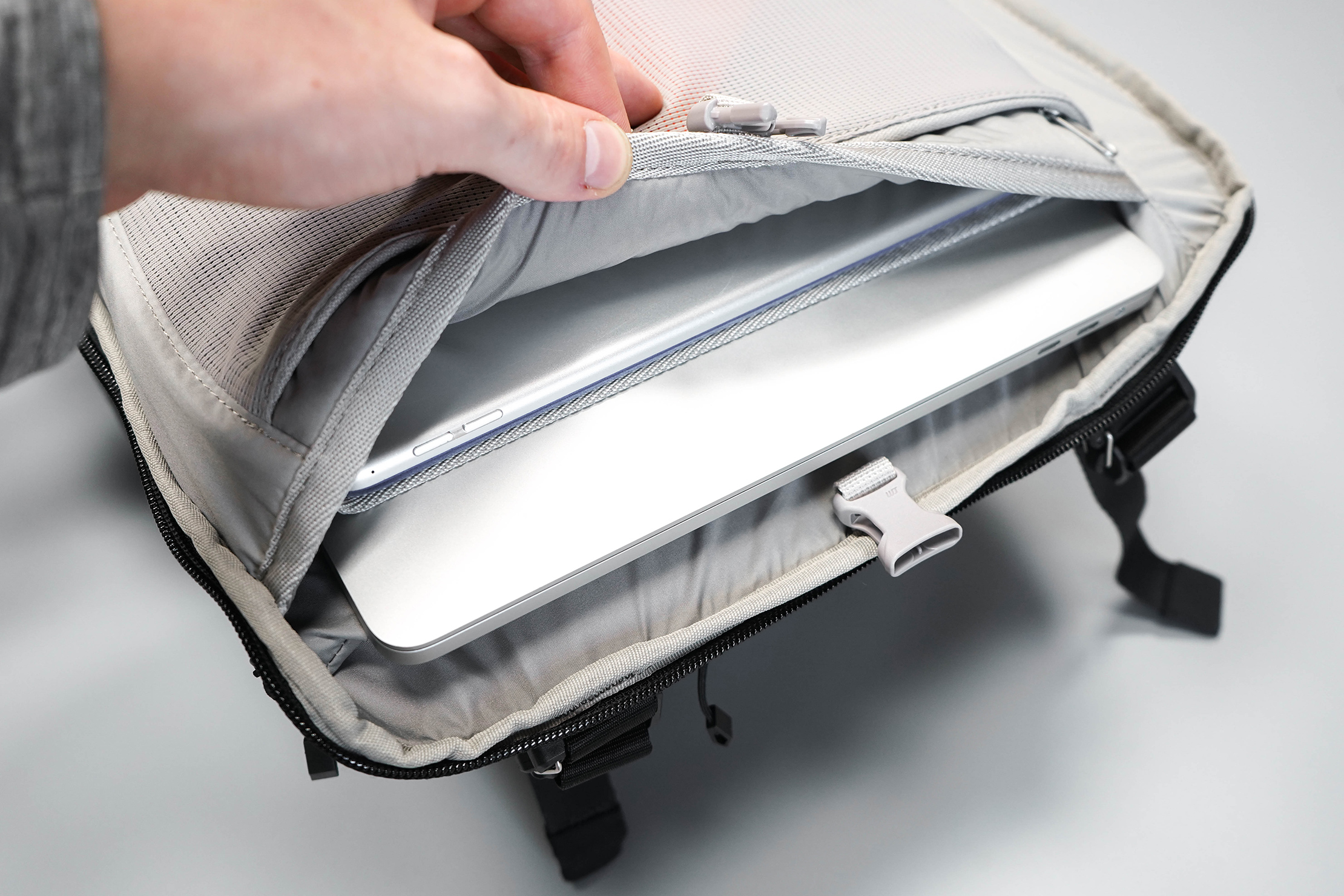
Behind the mesh pockets, you’ll find the laptop and tablet/document sleeves. The laptop sleeve, which has been designed to fit up to a 15’’ MacBook Pro, closes with a buckle. It has a decent amount of padding, which is helped by the beefy back panel. So, keep in mind, if you zip the back panel off, the laptop compartment will lose a significant chunk of padding.
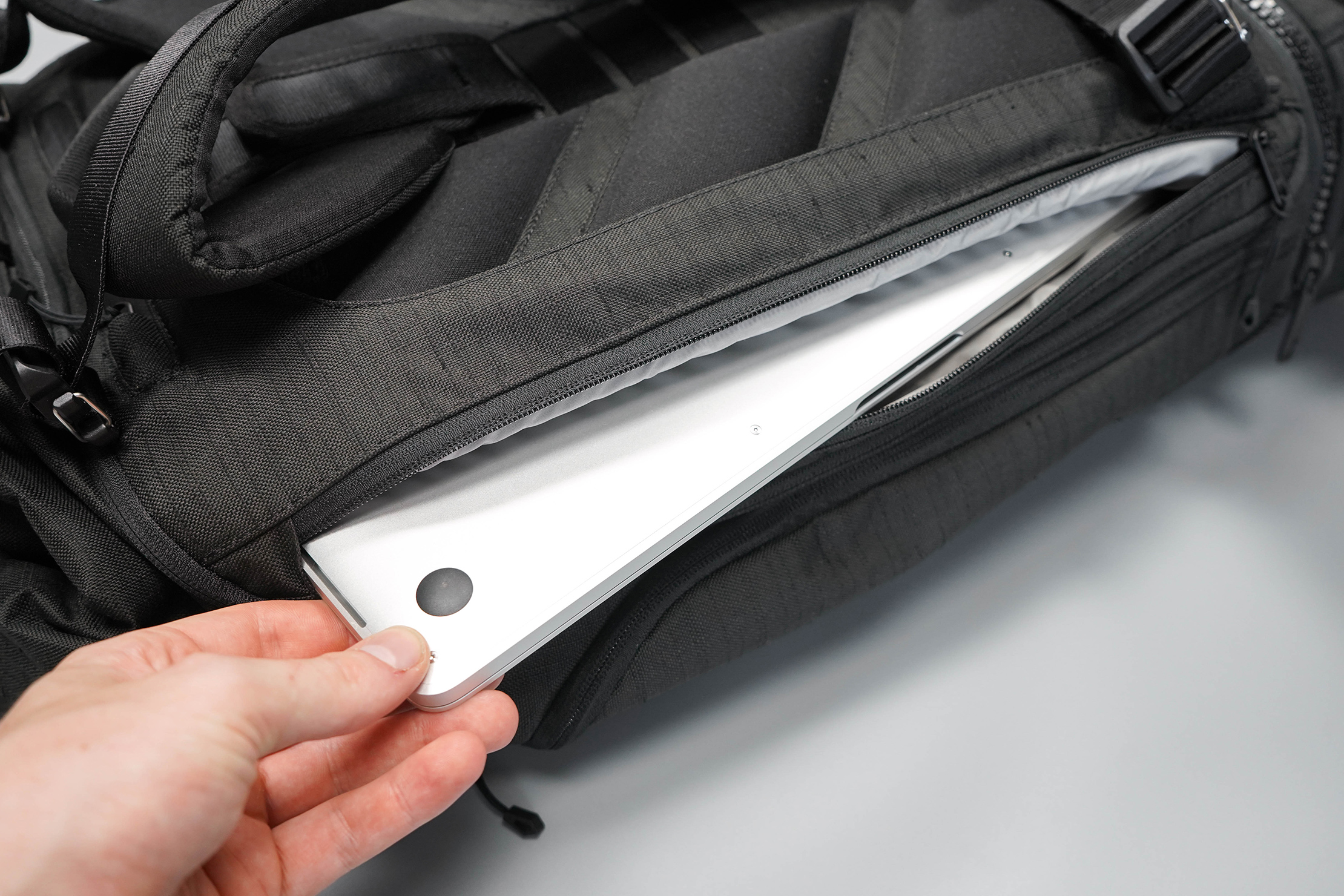
You can also access the laptop sleeve via a side zipper, so you don’t have to fully open up the pack to grab your laptop. We think this is a nice touch. We also like that the side zipper has a padded bumper, ensuring your laptop doesn’t slide around.
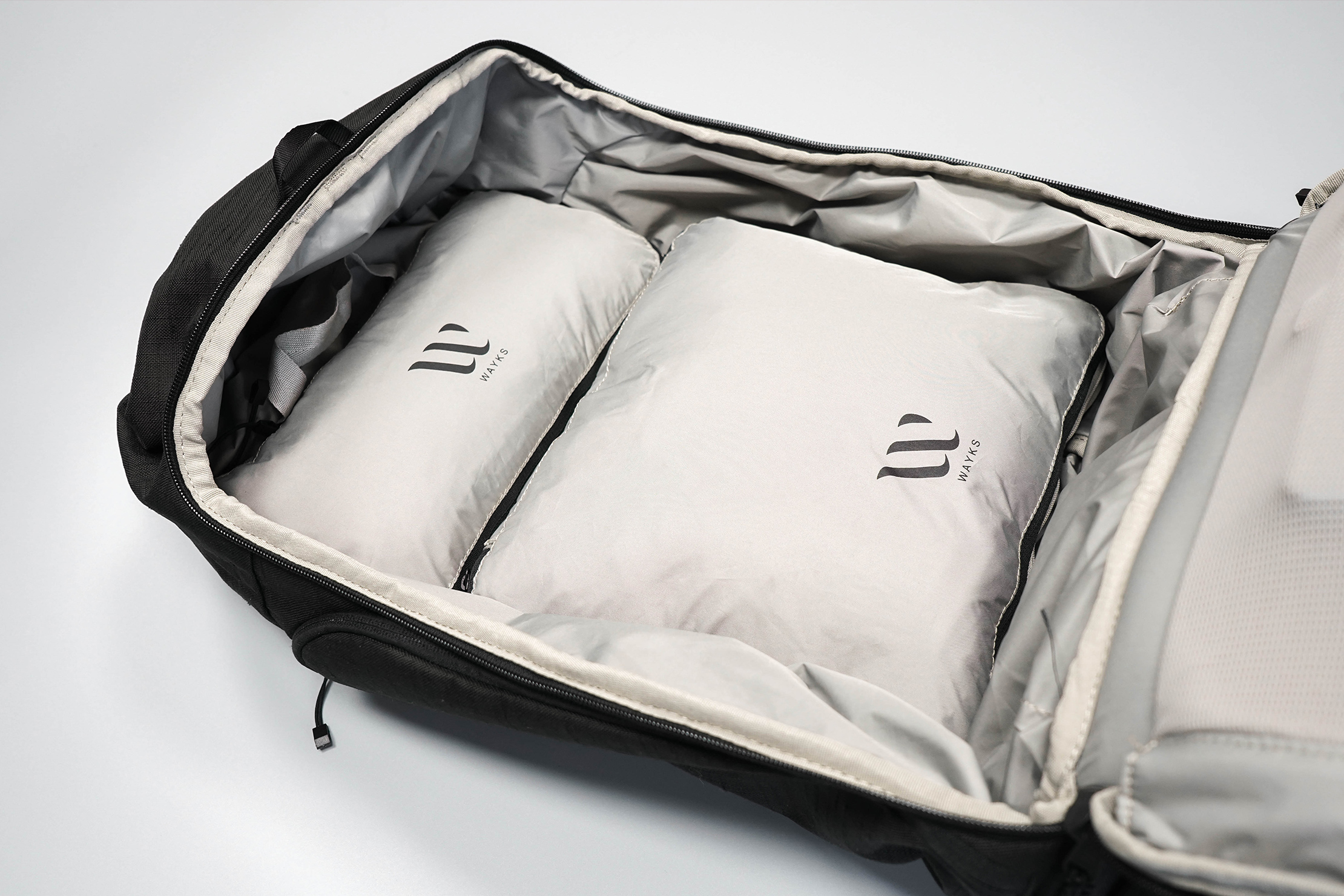
The rest of the main compartment is open space to do with what you will. WAYKS sells packing cubes designed to fit perfectly into this space and to help keep your stuff from descending into chaos. But you also use other packing cubes here (we have a guide to help you choose the perfect one for you) or go without if that’s your thing.
And that’s it! You’ve made it. Well, almost.
Durability & Testing
We’ve been testing the WAYKS ONE the Travel Backpack Original as a daily driver for two weeks around Detroit, Michigan. As we mentioned oh-so-long ago at the beginning of this review, we weren’t expecting it to perform very well. There just seemed to be too many things going on. But we’ve been very impressed on how well all the features function together. Even with all of the moving parts, the bag feels cohesive. We like that you can rock it as a travel bag and a day pack—and having a separate spot for your camera gear that you can also carry separately is nice too.
As for durability, we have nothing to report. The bag looks as good as new.
Usage Timeline
Condition: Excellent
- Modular design allows this bag to be used as a travel pack, day pack, camera bag, or ever a cooler
- Shoulder straps attachment height can be adjusted which is something we haven’t seen on many other bags
- Thick and dense padding on the entire harness system
Condition: Excellent
We are normally wary of any sort of gear that boasts lots of “travel features” because they can be very gimmicky products that target people that don’t know that much about travel gear. We were worried that this bag might fall into that category however we are happy to report that it has exceeded expectations! It is incredibly comfortable to carry both with and without the large hip belt and we’ve been using basically every feature on this bag. One feature in particular we love is the dual access to the main compartment. Roll-tops can be hard to see into and access so having the quick zip access to the laptop and organization panel is great. We’ve been really liking this bag overall and are impressed on how well all the features function together.
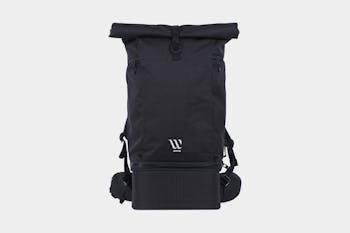






Get your questions about the WAYKS ONE answered from our team and the Pro Community right here on the page. Plus, join discussions with other members about gear, guides, and more.
Join Pack Hacker Pro or, Sign In